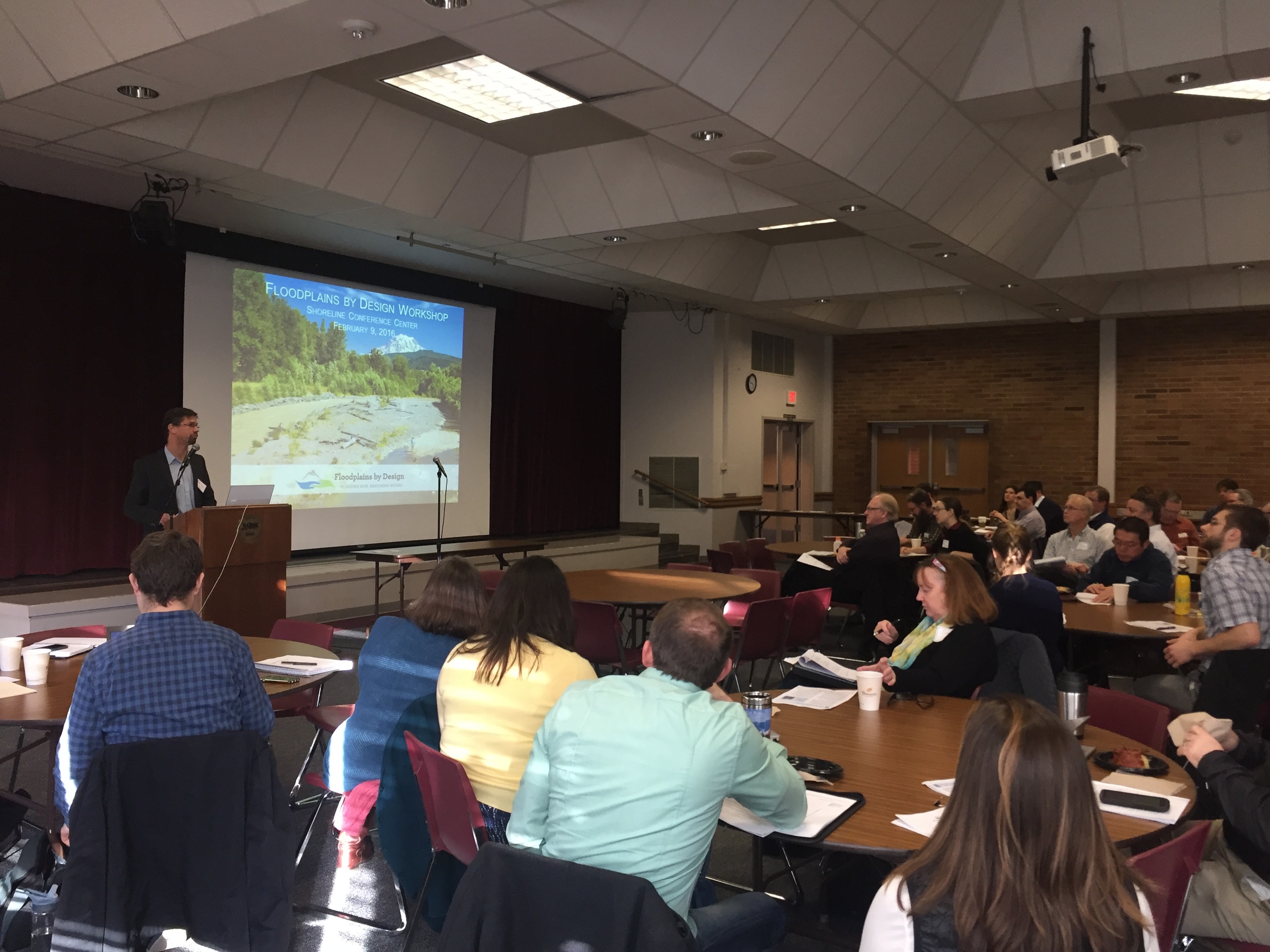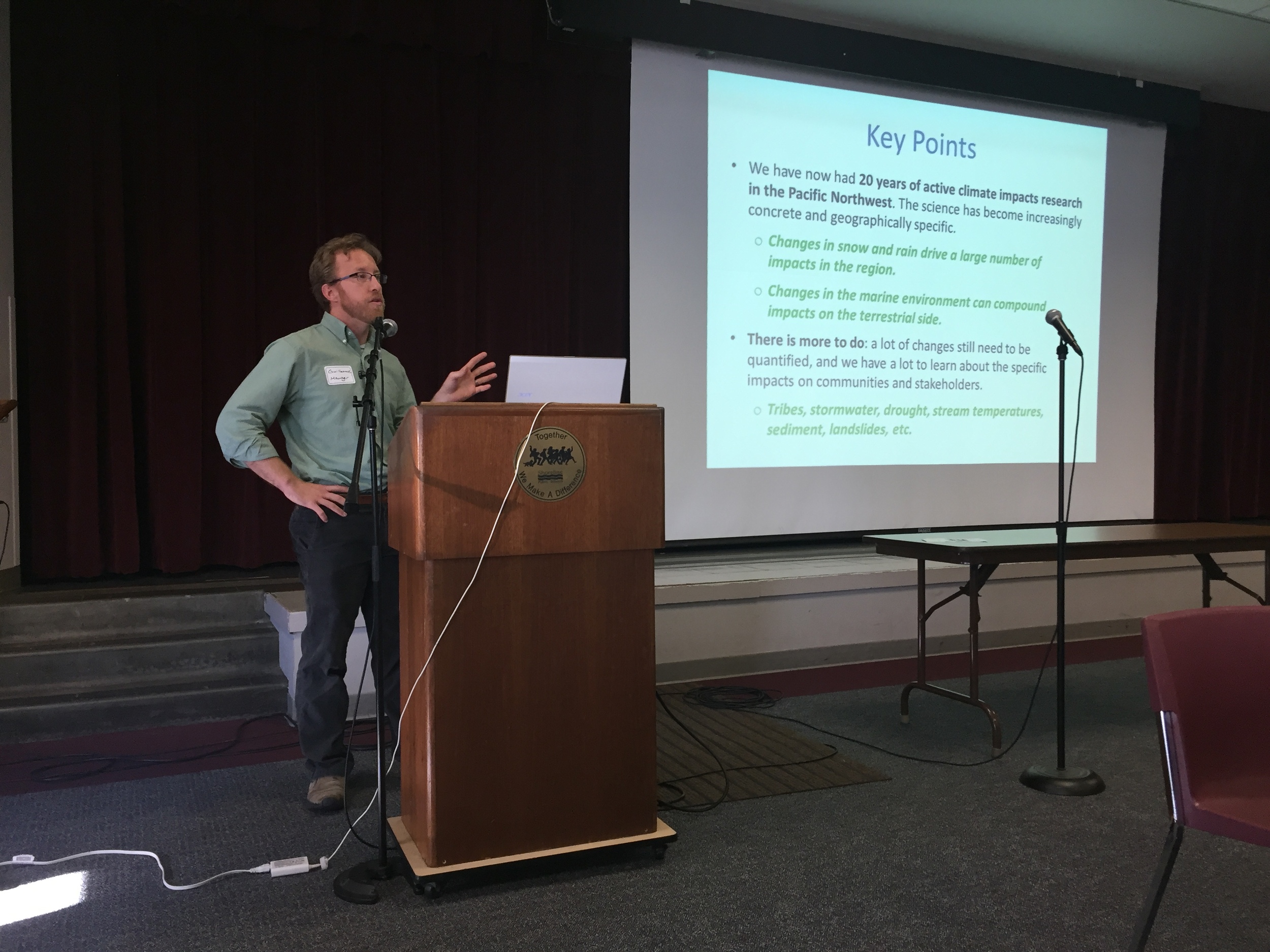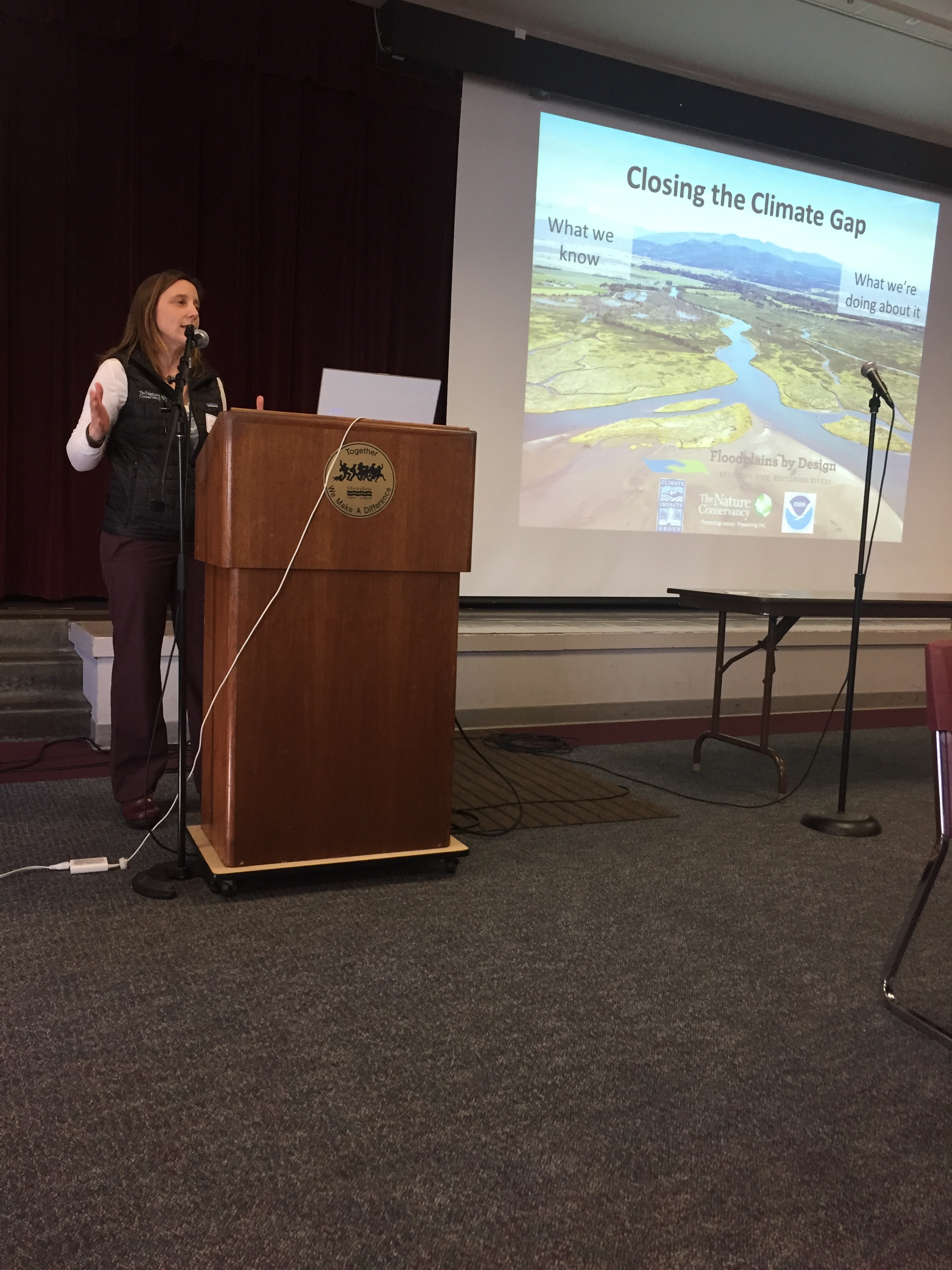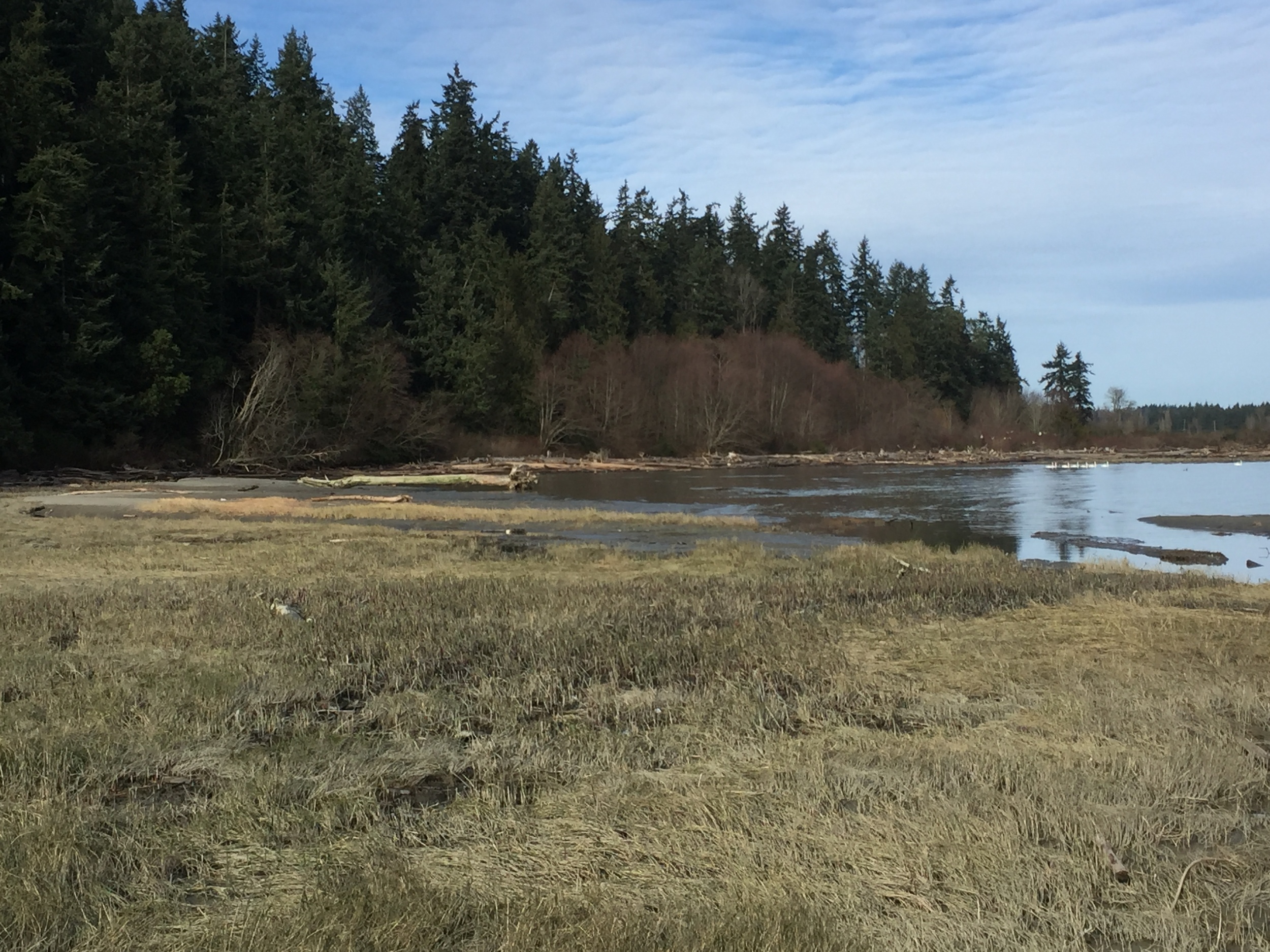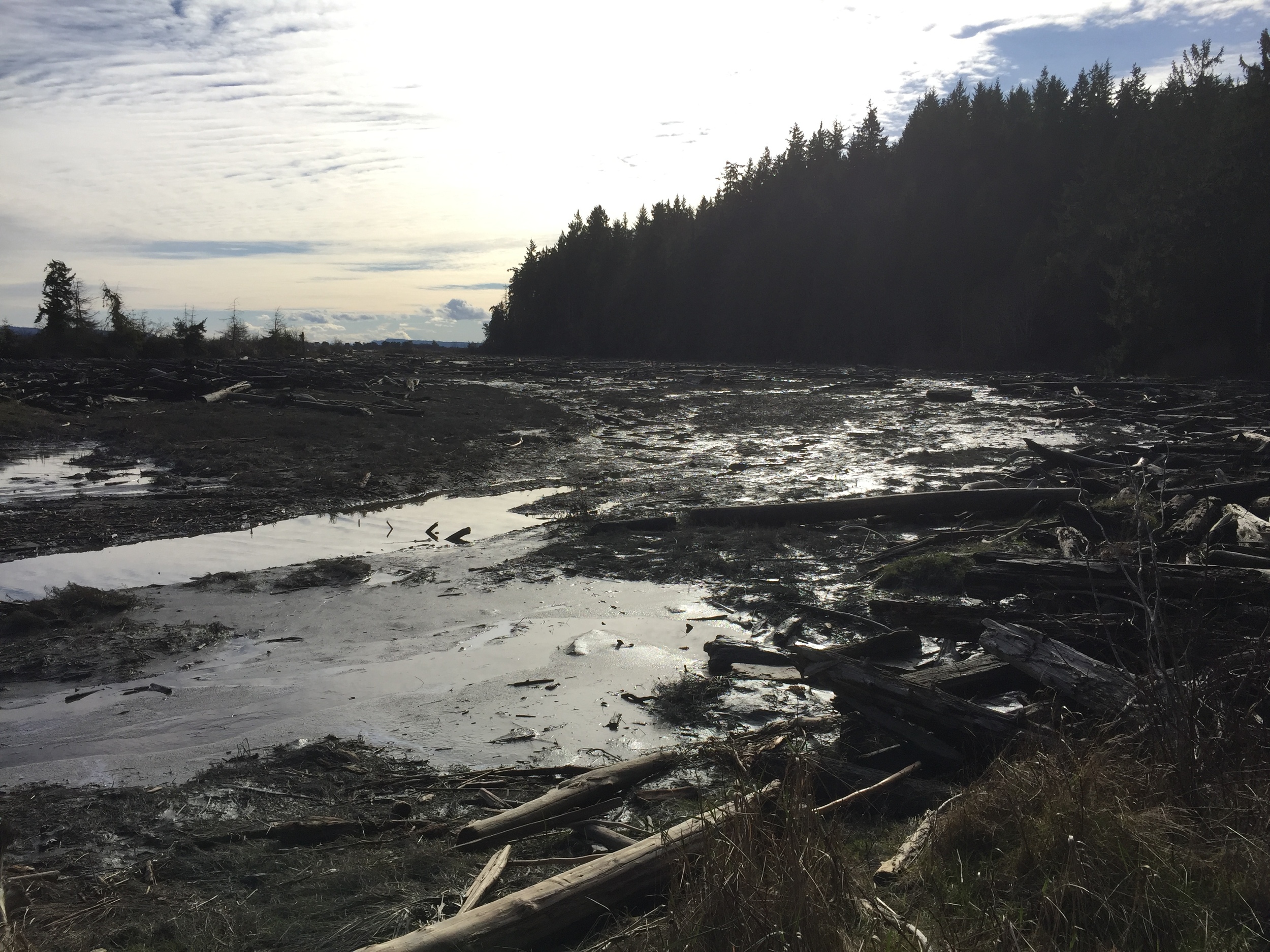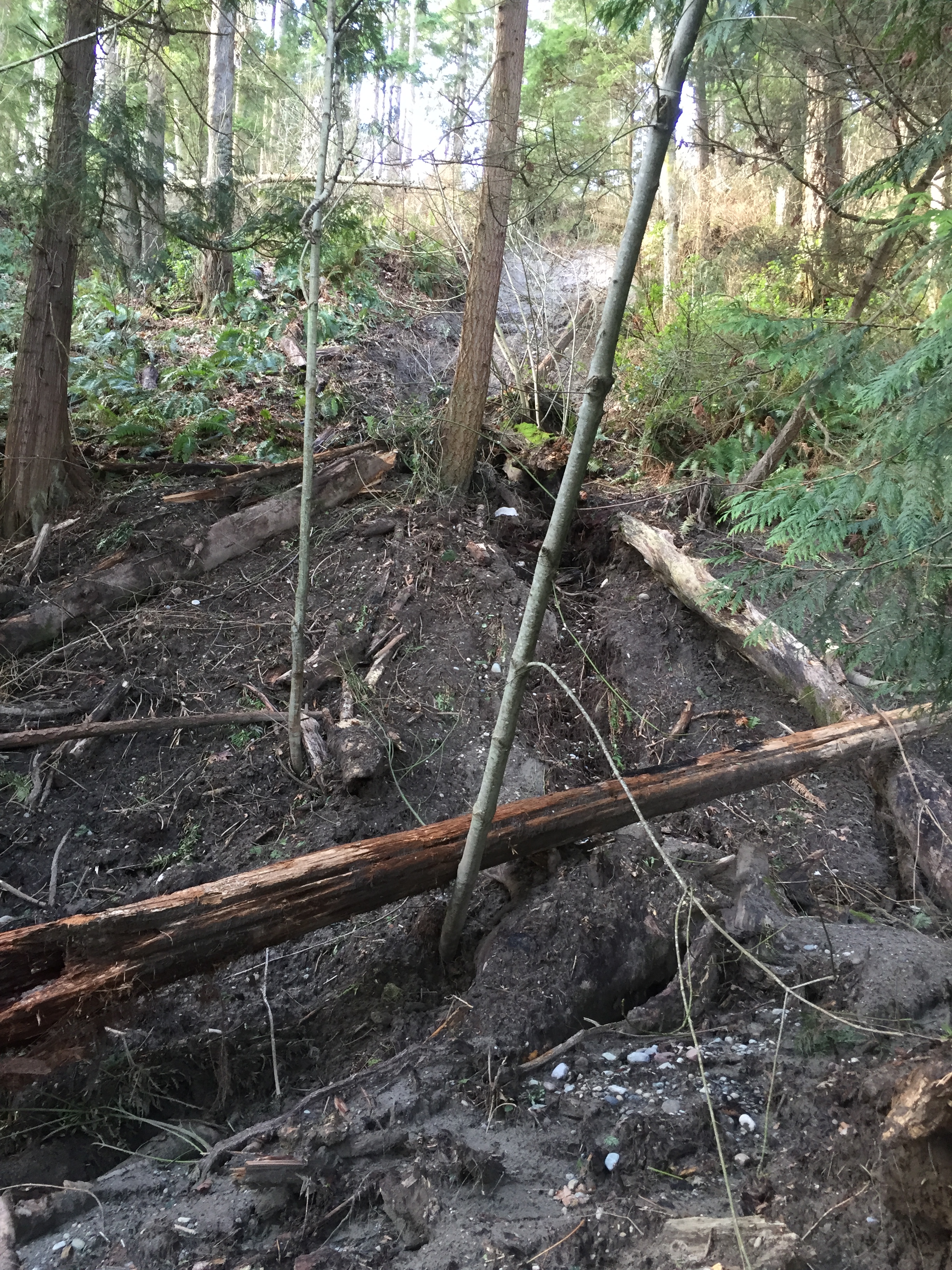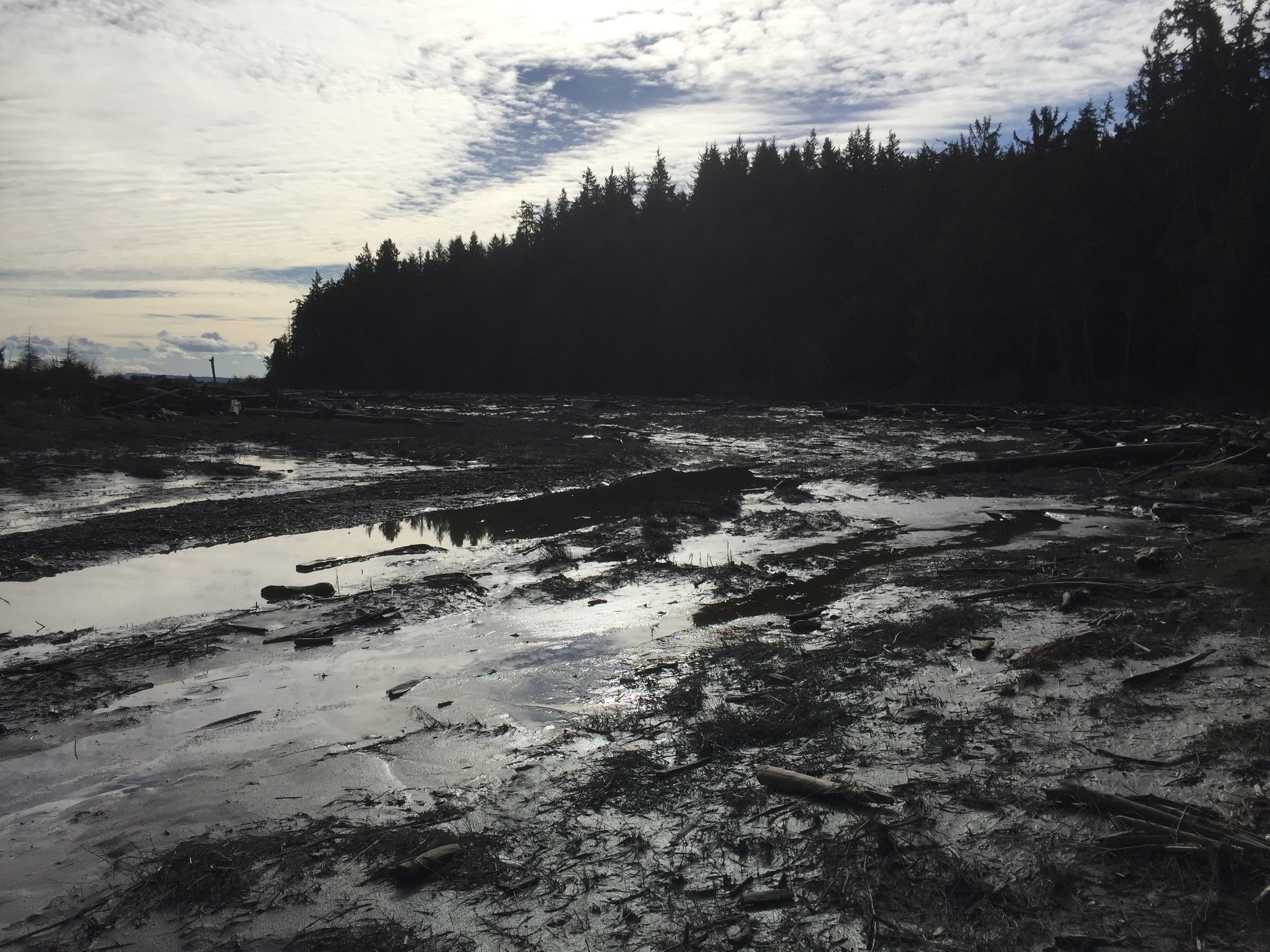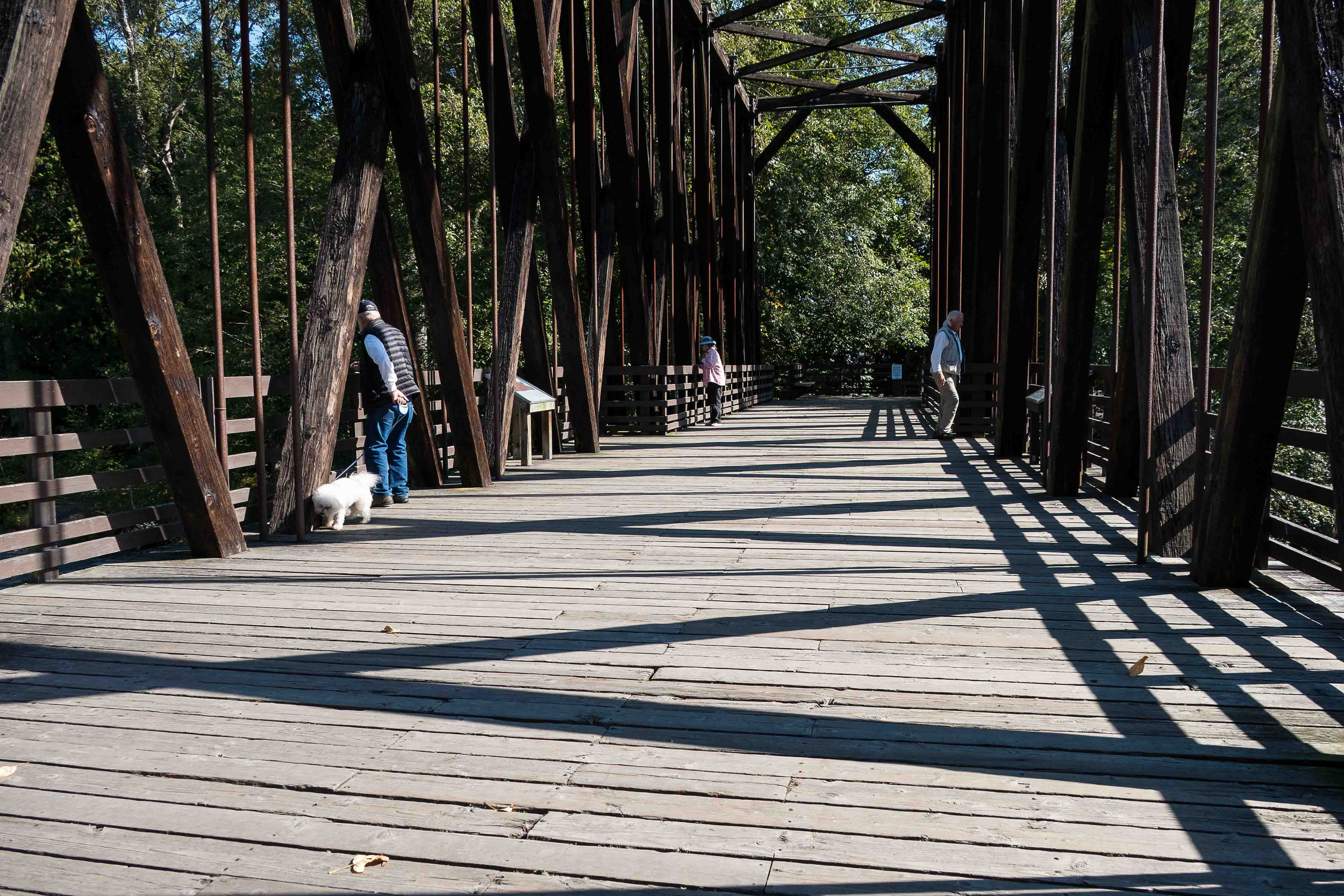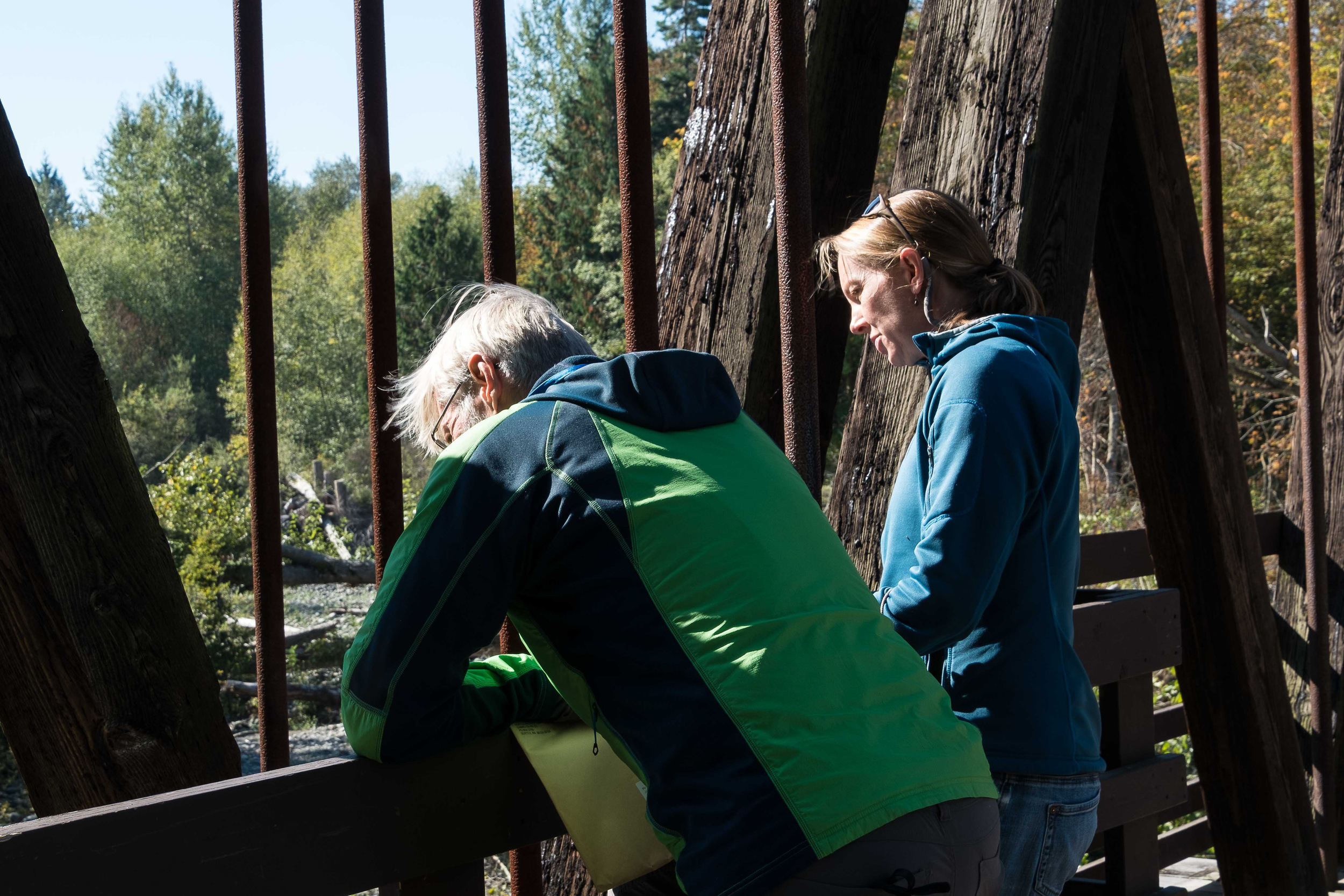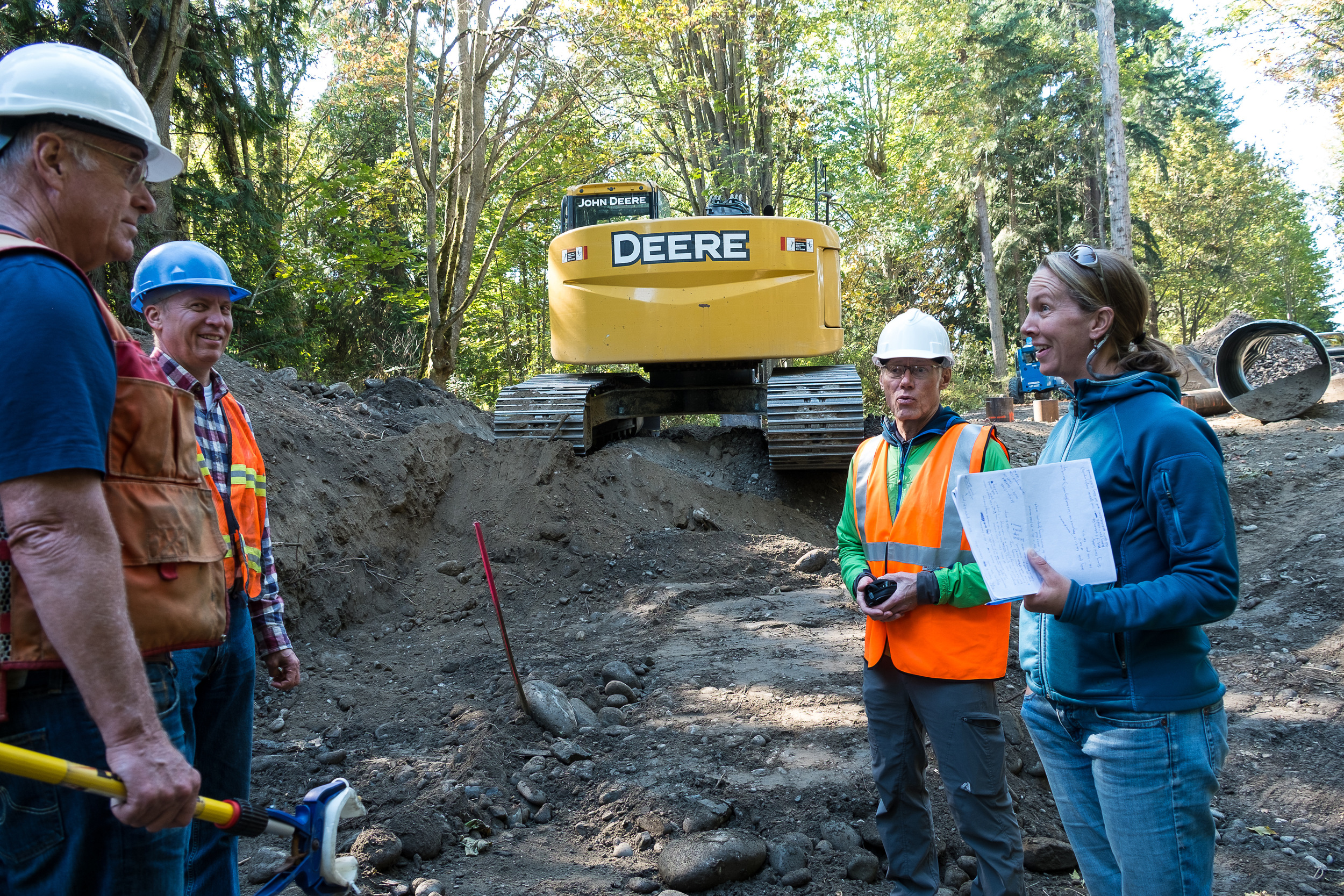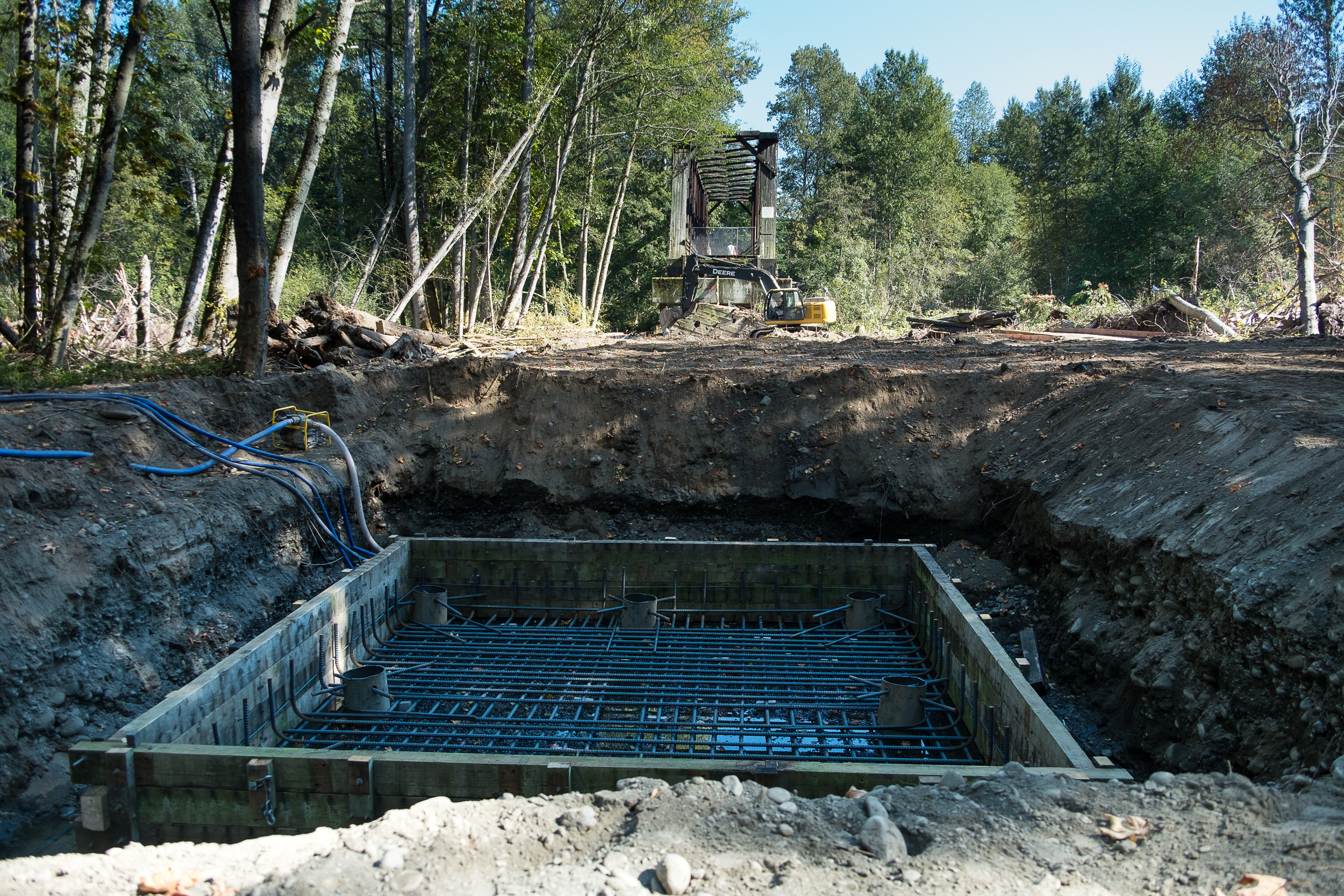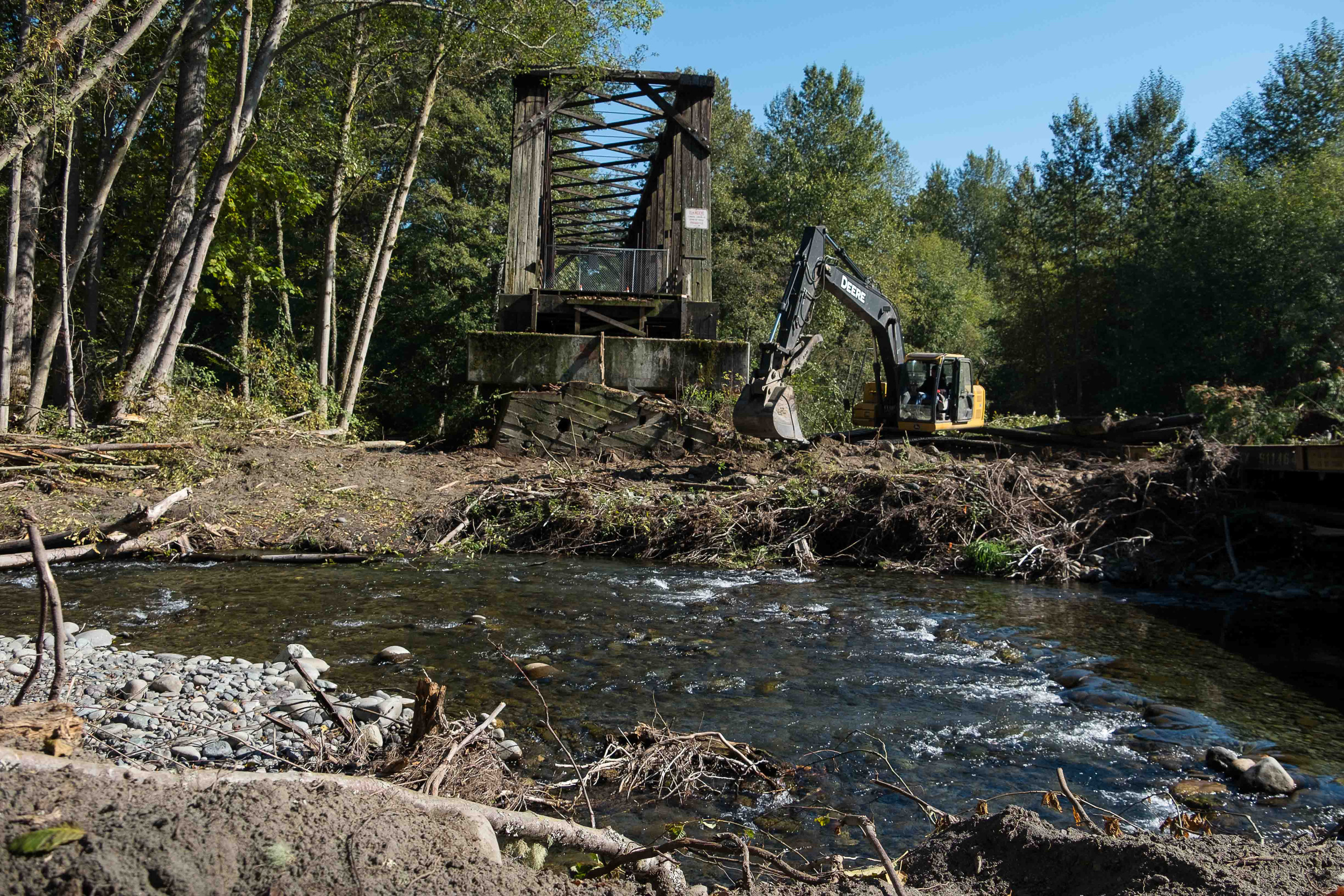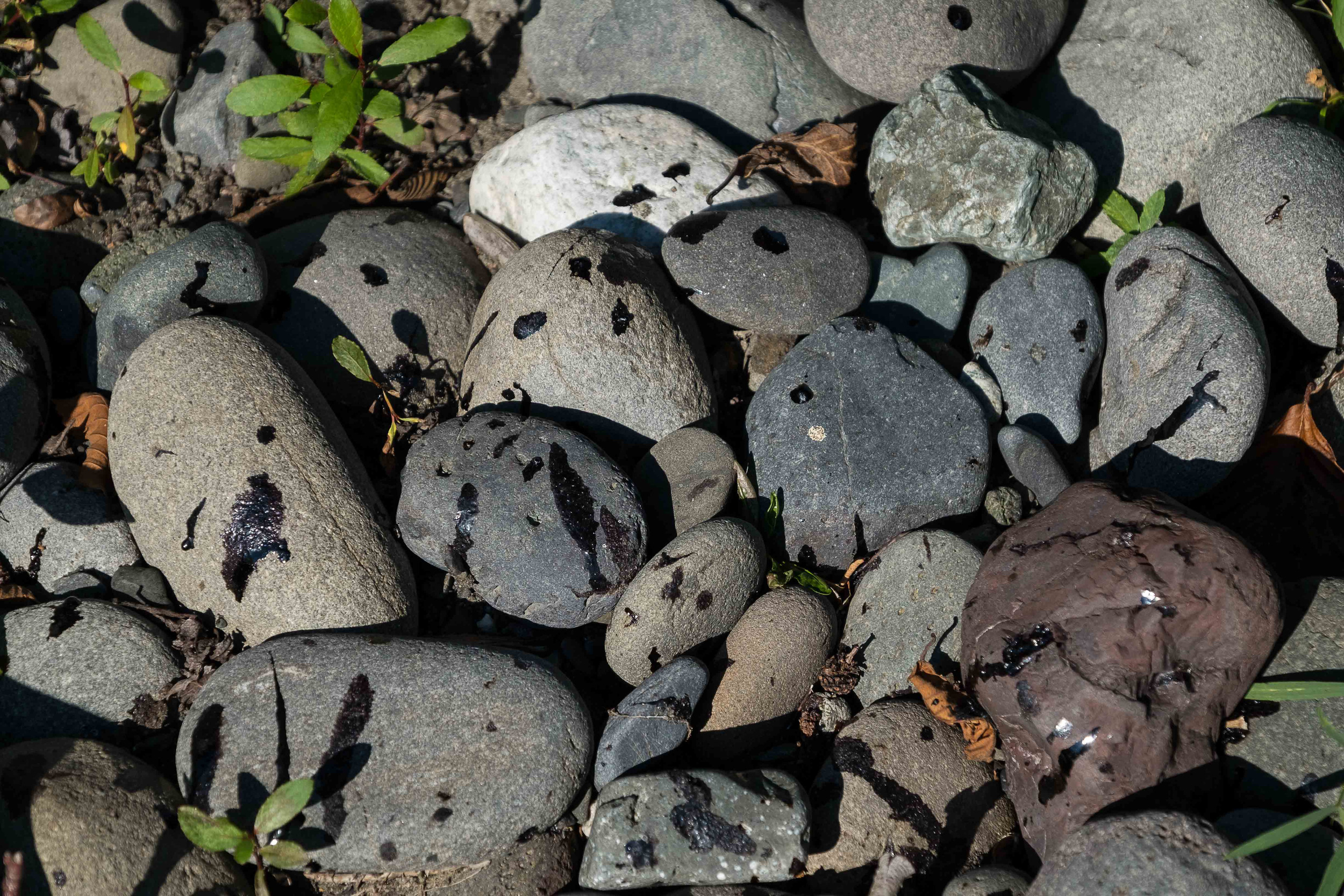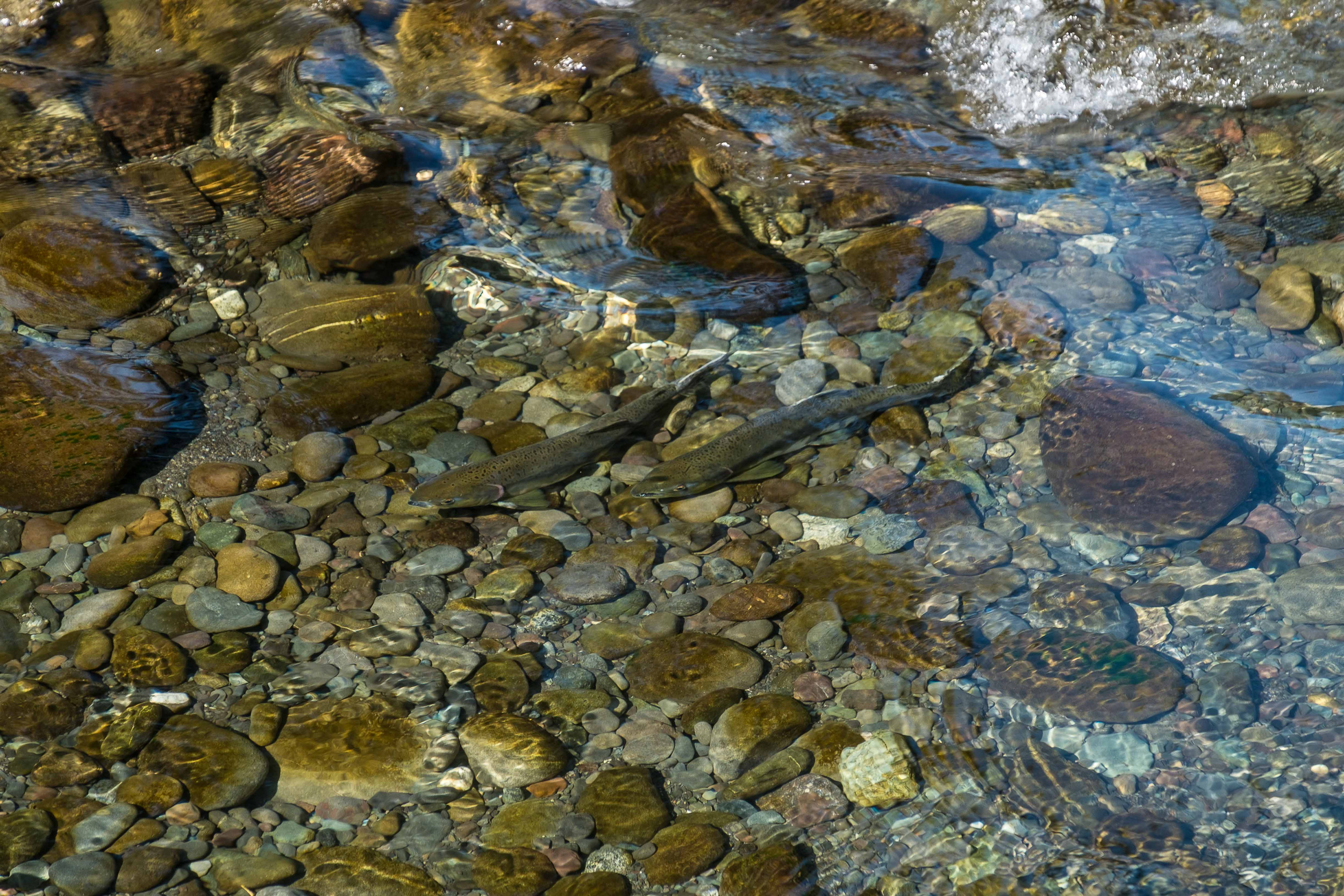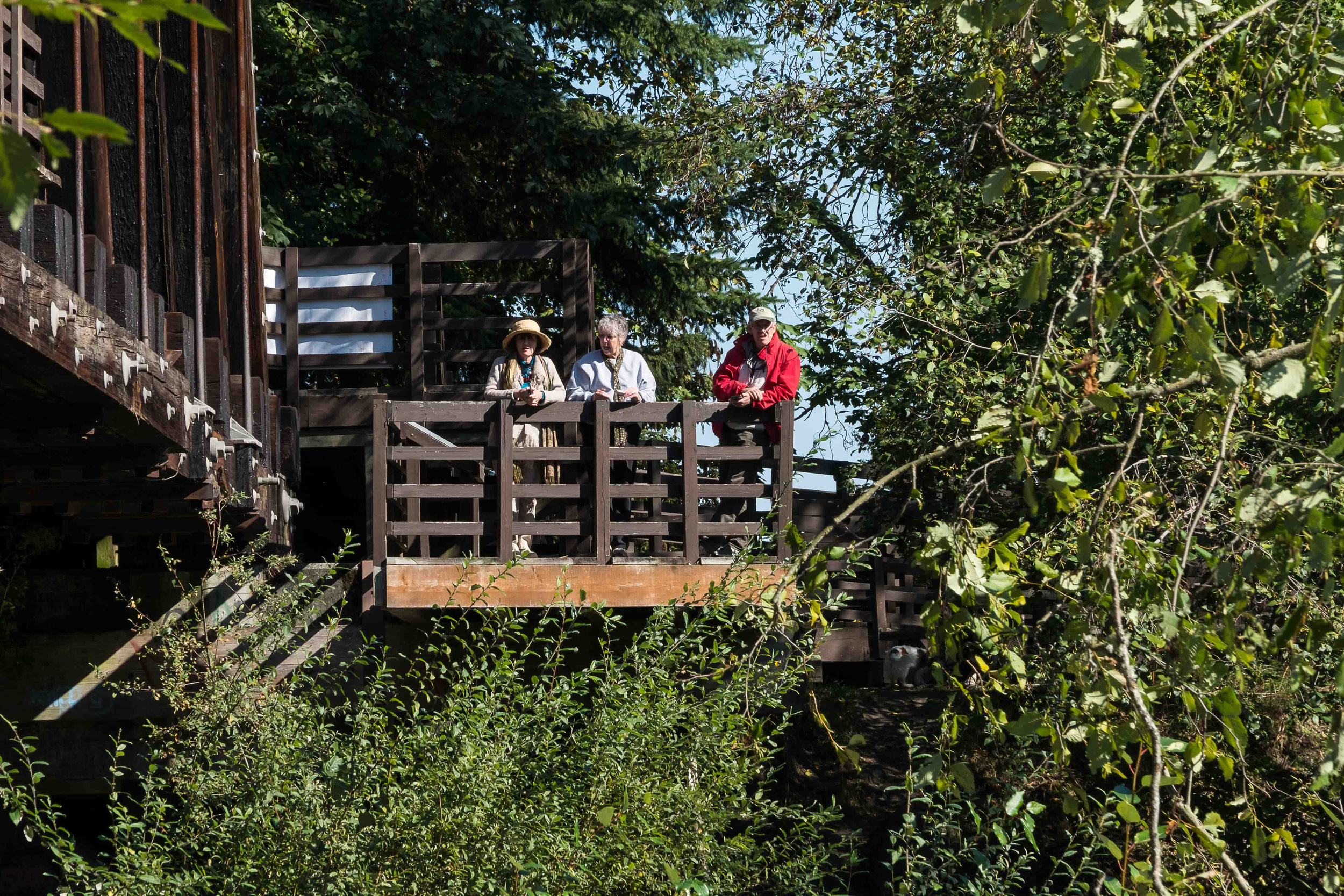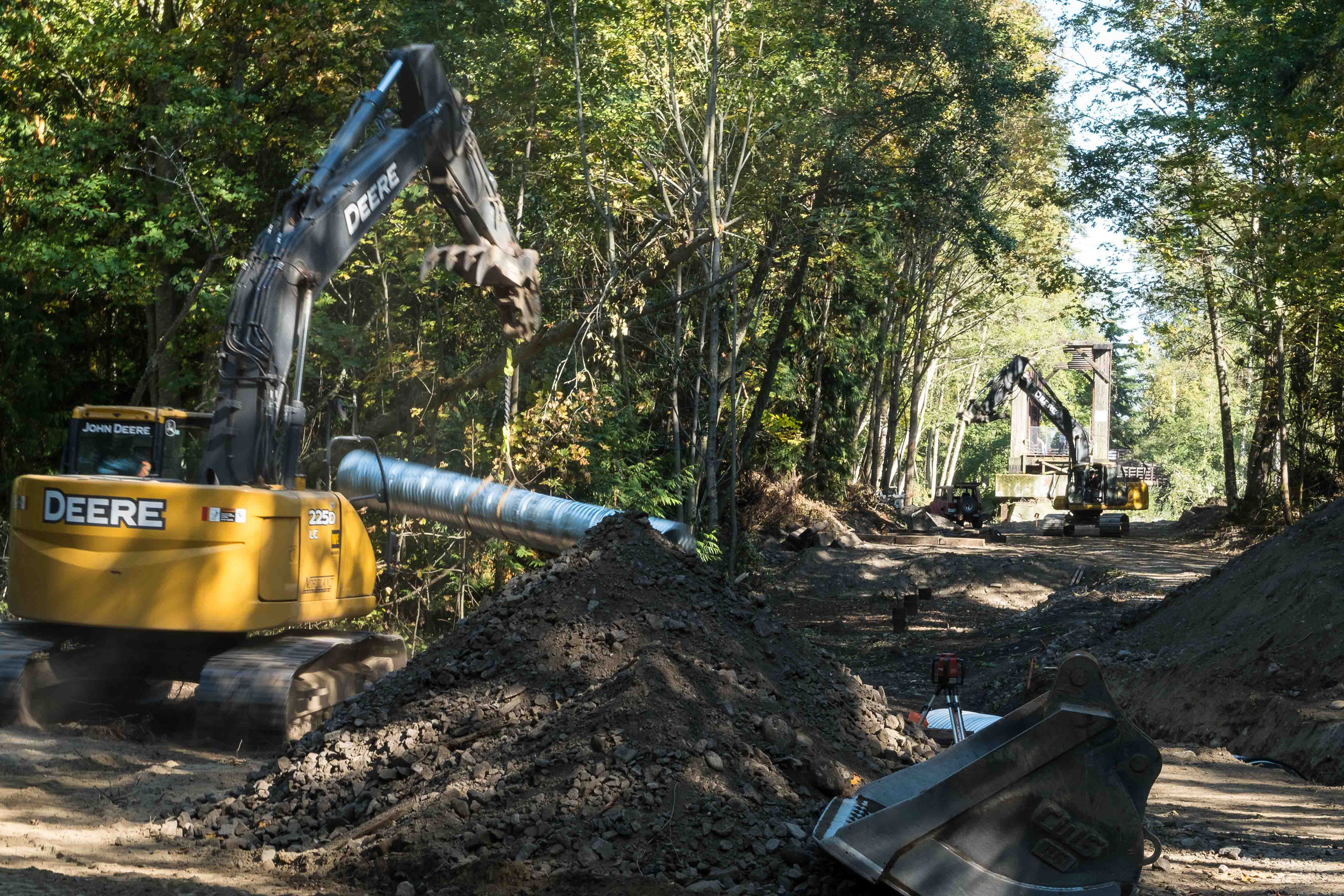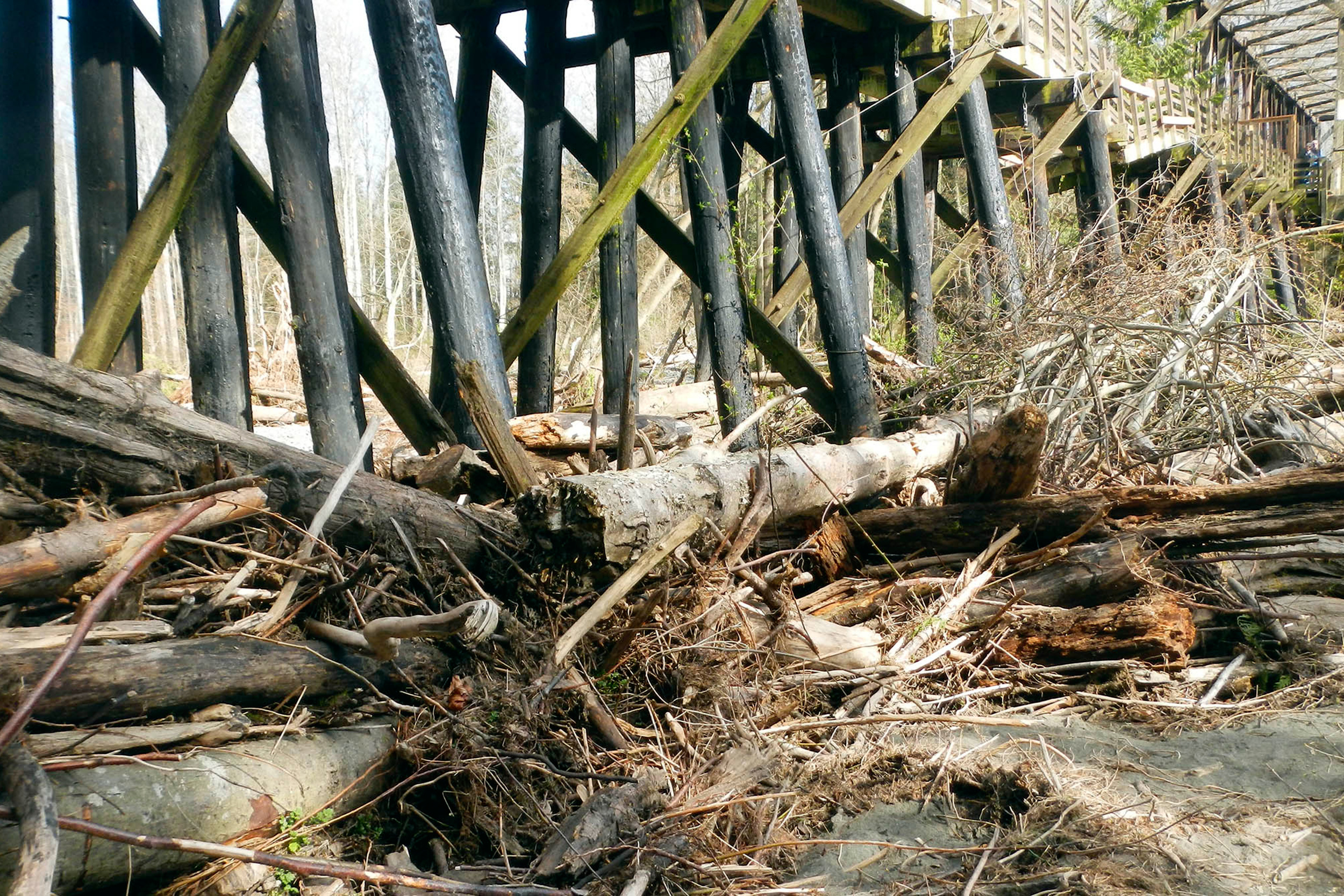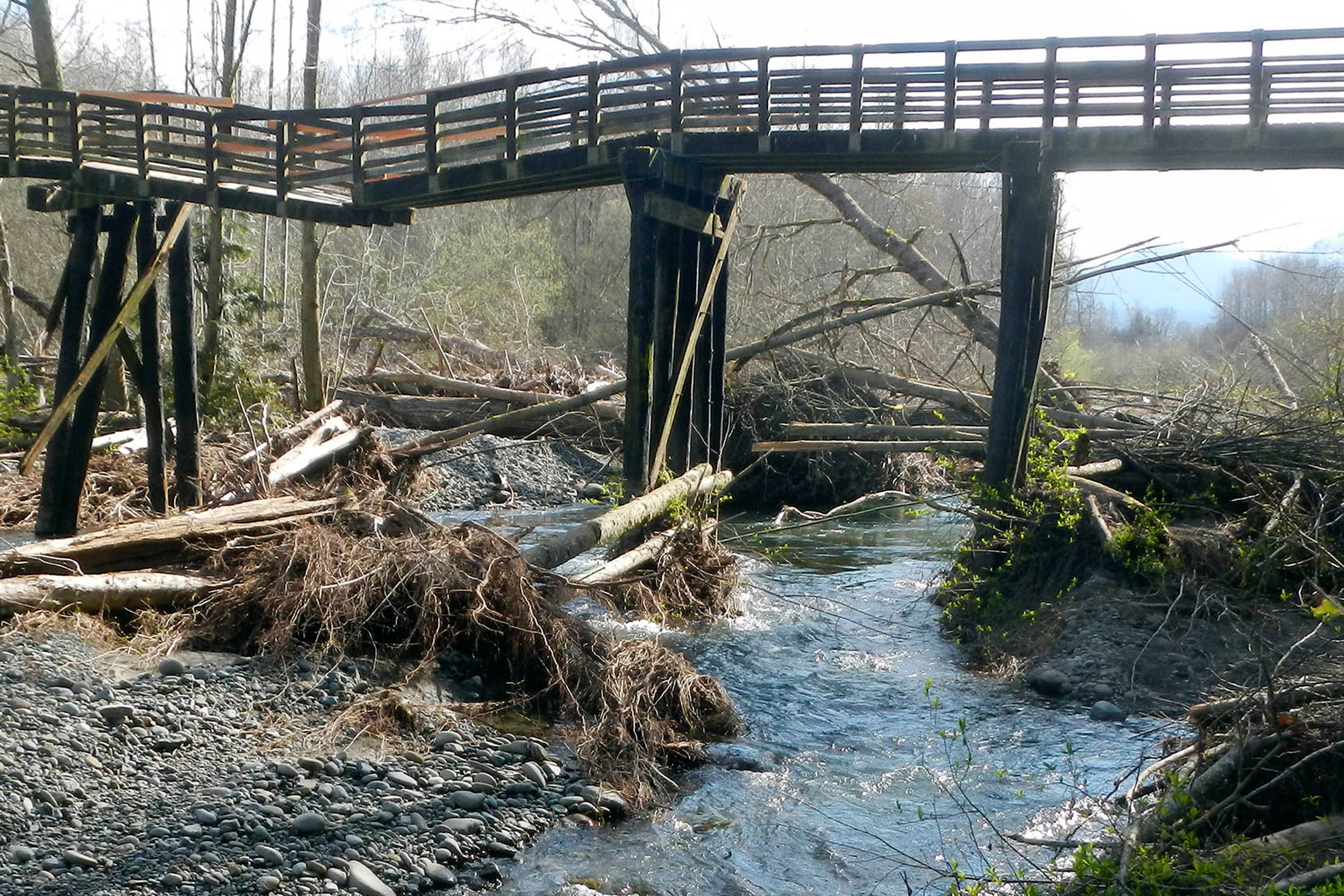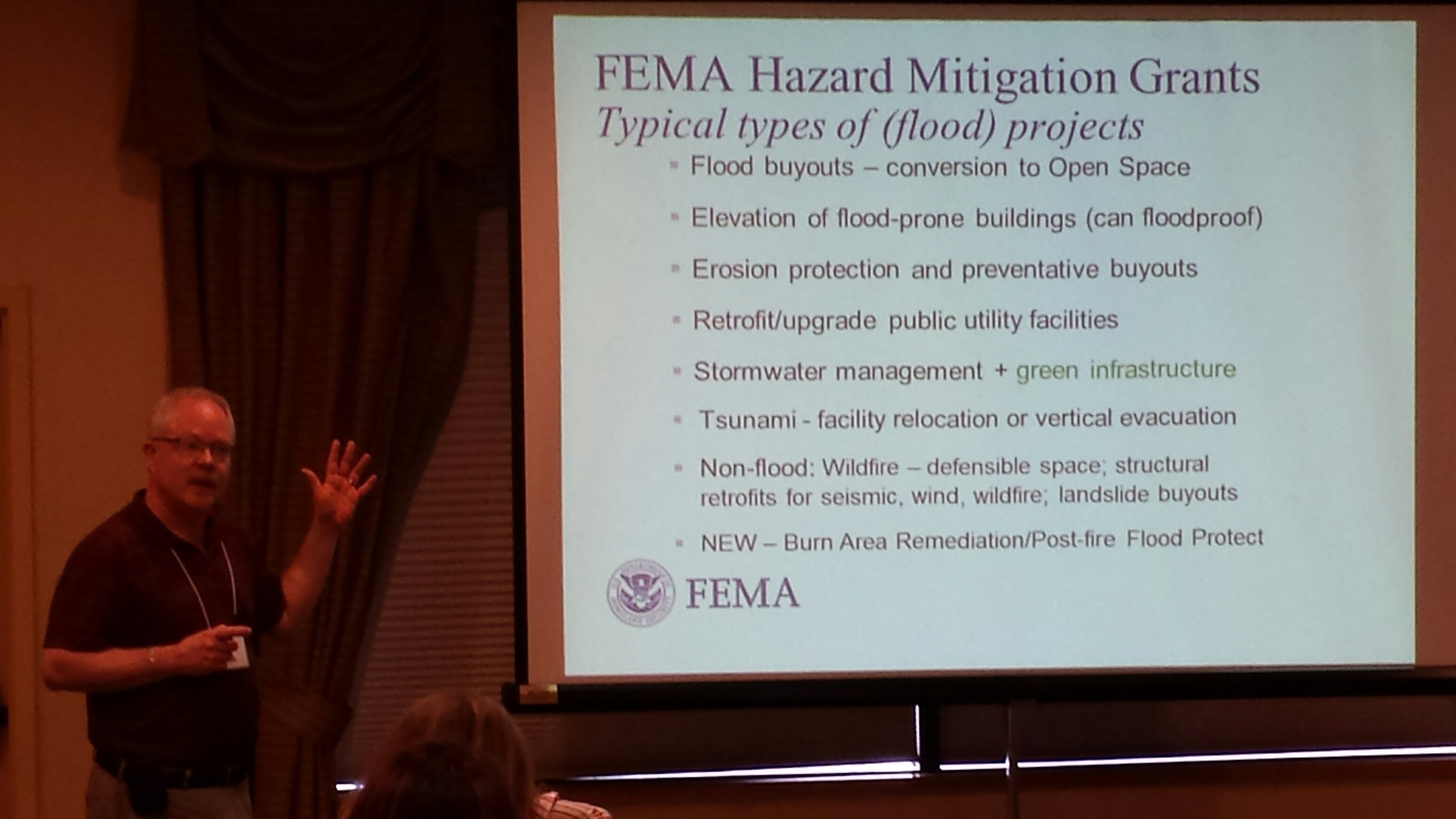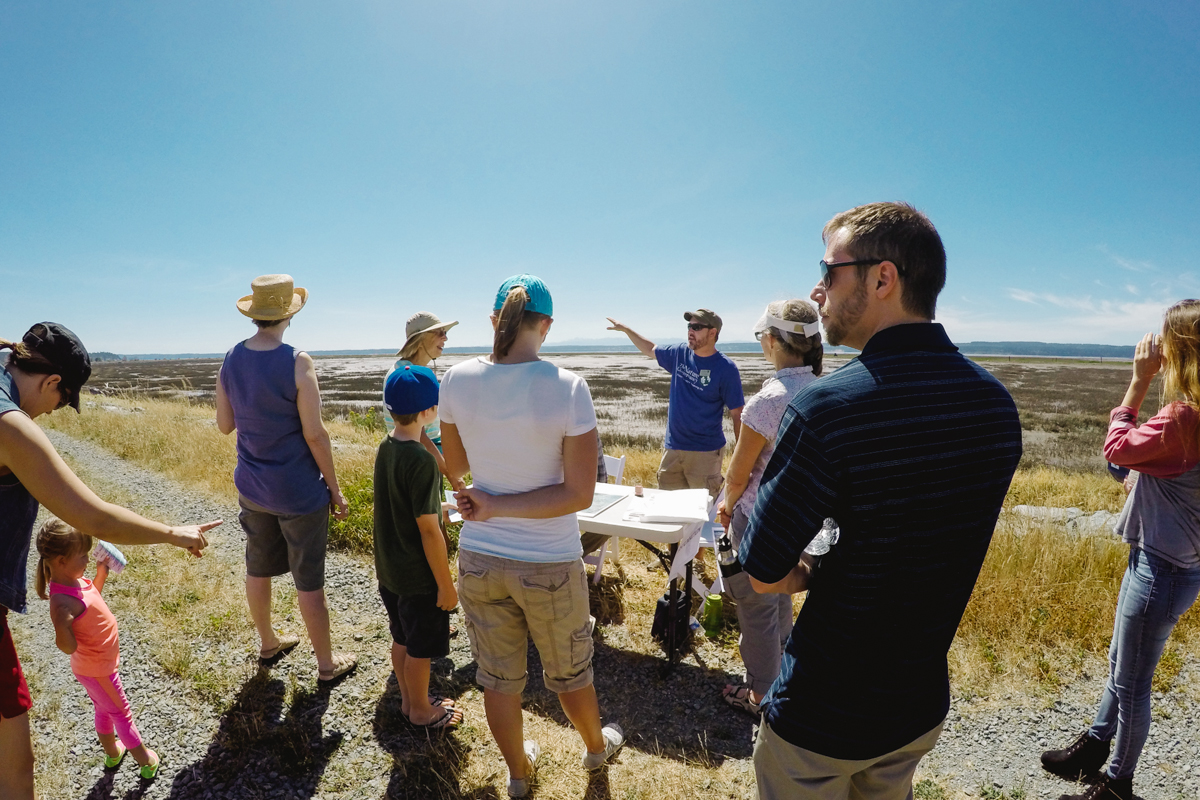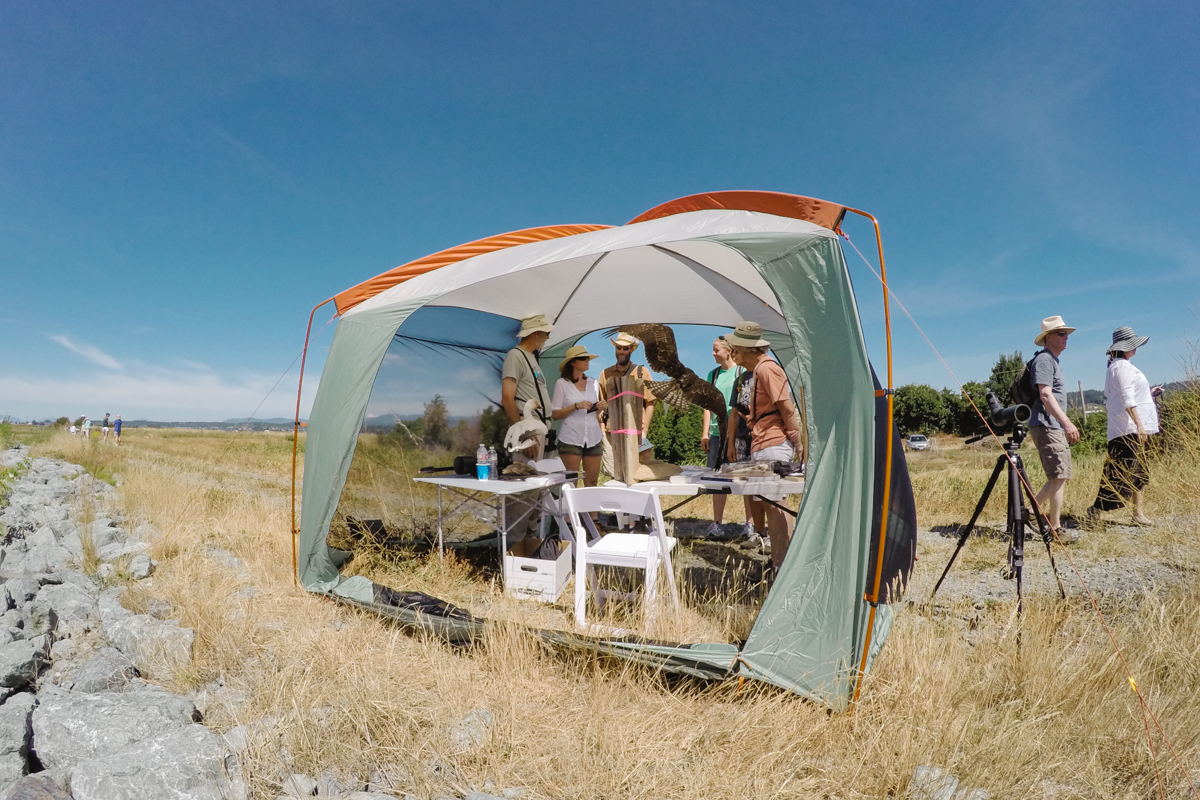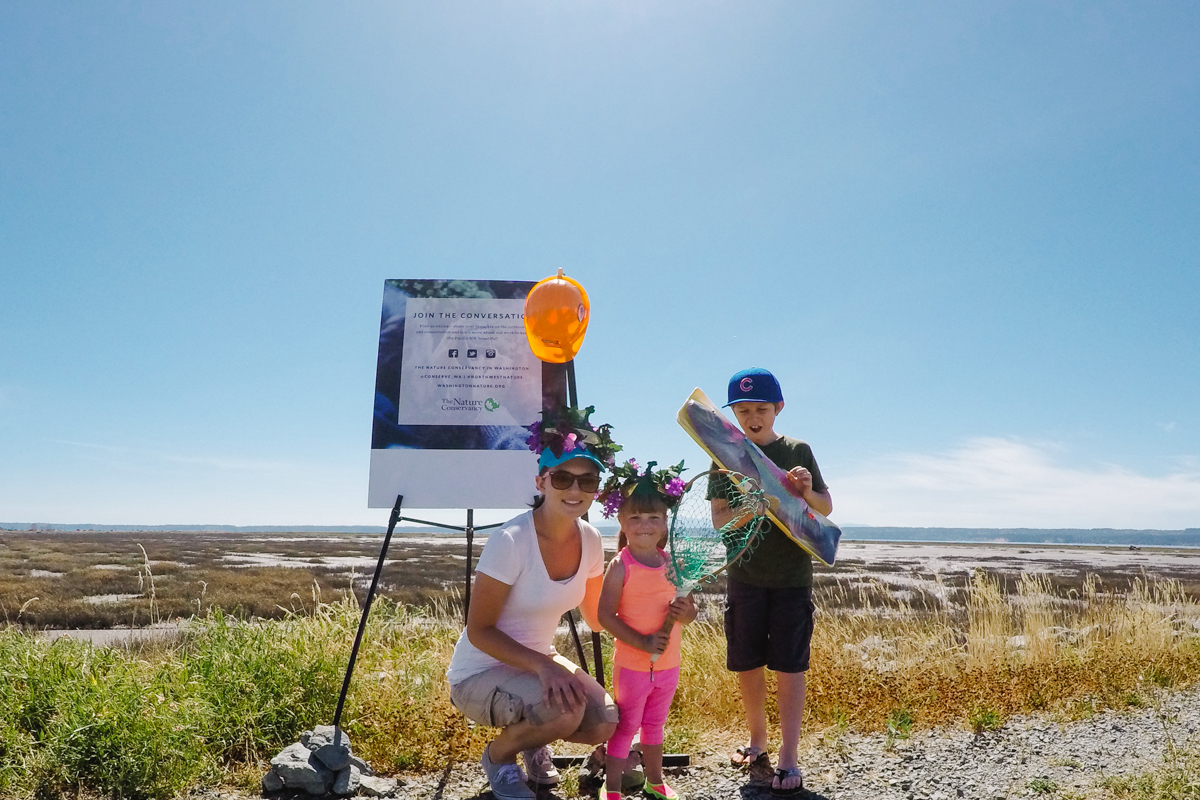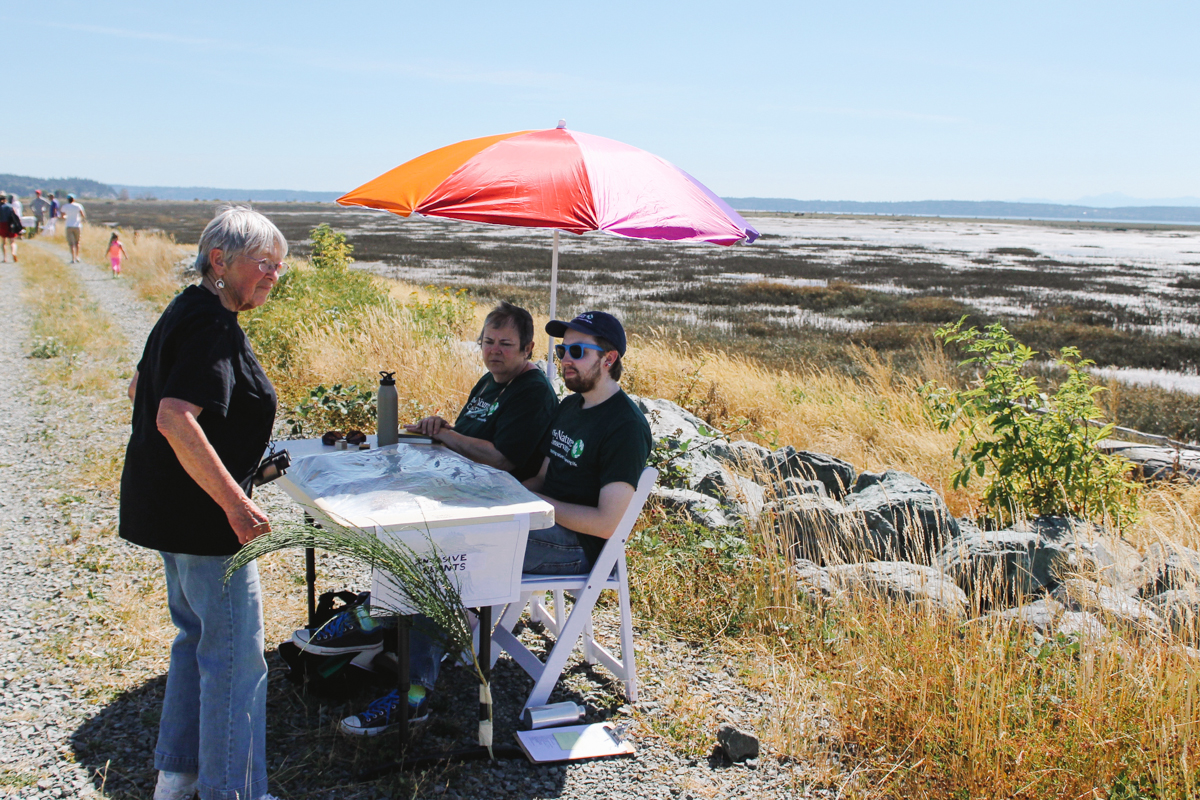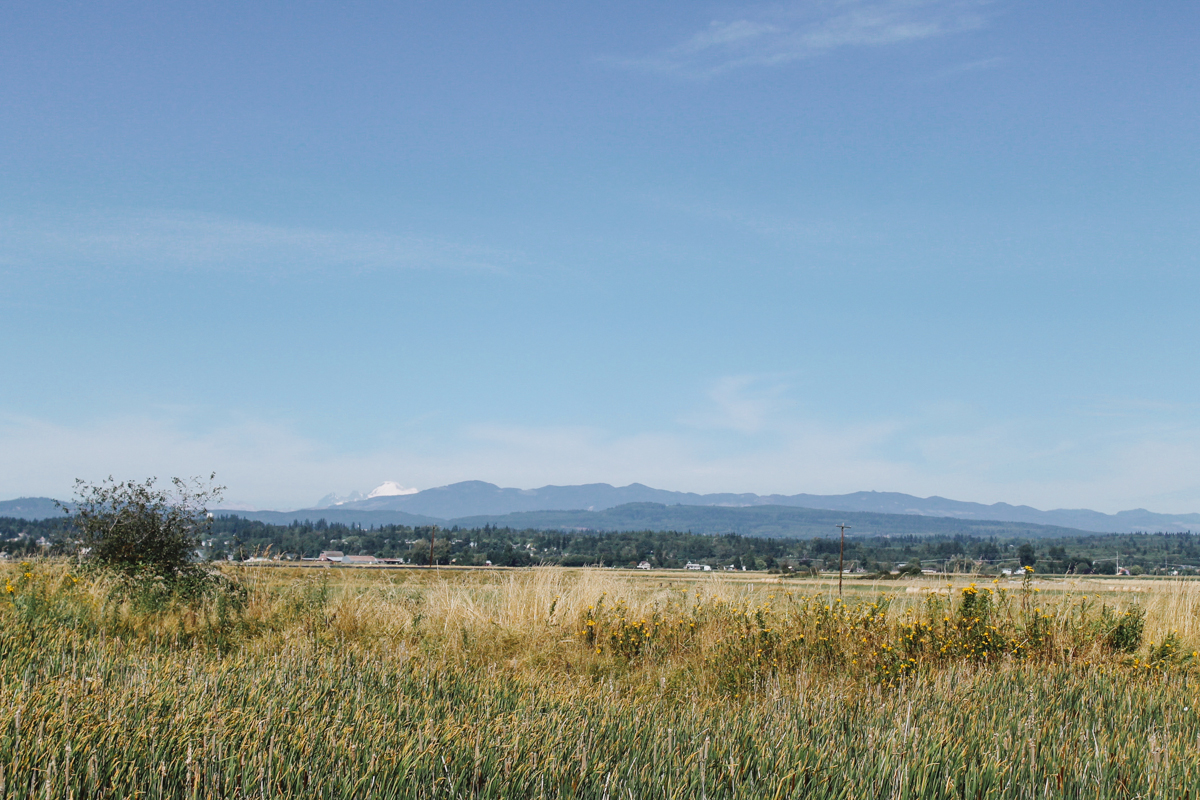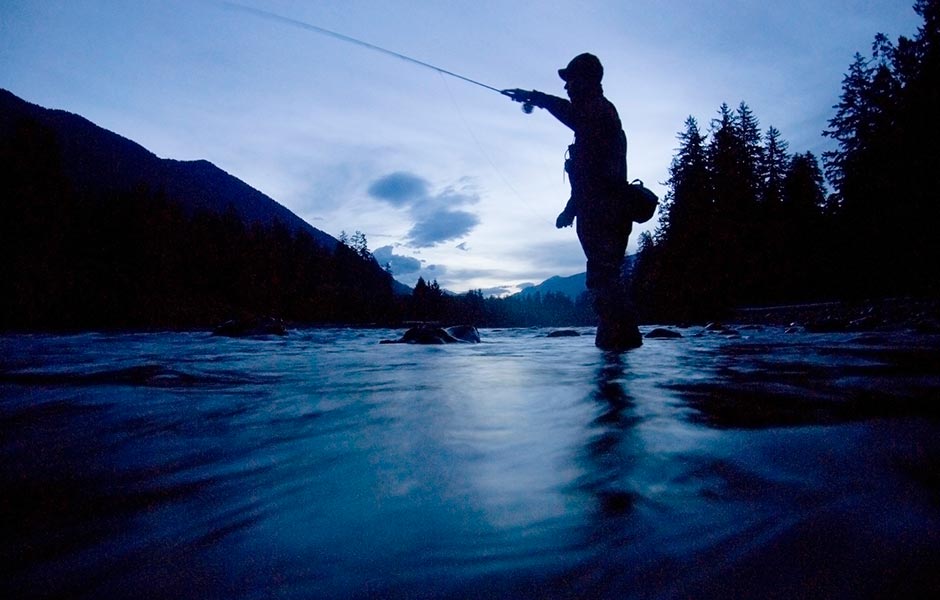Explore maps that show how fluid rivers in Washington state have been over time.
What do Multiple Benefits Look Like in a Watershed?
Integrating Climate Into Floodplain Planning
Written by Robin Stanton, Media Relations Manager
Photographs by Chris Hilton, Grant Fundraising Director
Floodplain leaders from around the Puget Sound region gathered today for a workshop on advancing floodplain restoration, including a new focus on integrating climate change data.
“There’s a big gap between what we know and what we’re doing about it,” says Julie Morse, the Conservancy’s regional ecologist.
“It’s not unique to Puget Sound, we find it all over the country.”
At today’s workshop, floodplain leaders will begin to develop strategies for including climate impacts into the work they’re already doing.
The Conservancy has been working with the University of Washington Climate Impacts Group to take its recent Puget Sound Climate Synthesis Report and turn it into information that is really useful to city, county and state leaders grappling with these issues on the ground. Today’s workshop is a chance for floodplain leaders to work hands on with this information.
LEARN MORE ABOUT OUR FLOODPLAINS WORK
Landslide at Livingston Bay
Written and Photographed by Julie Morse, Regional Ecologist and Joelene Boyd, Stewardship Coordinator, Puget Sound Program
“Geology and topography make the
landscape vulnerable, but it is the
hydrology that pulls the trigger.”
We recently had a landslide on our Livingston Bay property. No major damage was done besides damaging the trail. See photos in the slideshow above!
Floodplain Restoration along the Olympic Discovery Trail
A win-win project for people, nature and our treasured salmon
Written by Jenny Baker, Senior Restoration Manager, and Photographed by Julie Morse, Regional Ecologist
When a popular recreational trail on the Olympic Peninsula was damaged by a flood and closed last February, there were two options: either 1) fix the trail for walkers and bikers, or 2) fix the trail for walkers and bikers AND do it in a way that improved fish habitat and reduced flood risk. The choice was obvious: build a project with many positive outcomes.
The Olympic Discovery Trail is a rails-to-trails system that currently extends from Discovery Bay to Port Angeles and receives 100,000 visits per year. When a portion of the trail over the Dungeness River near Sequim was damaged, walkers and bikers were anxious to get it fixed quickly. Randy Johnson, Habitat Program Manager with the Jamestown S’Klallam Tribe, saw a great opportunity for a win-win-win project, but he had to act fast to make sure the project could incorporate benefits to fish and flooding, and get the trail back in use.
The damaged section was part of a 585-foot-long trestle supported by creosote pile structures every 16 feet across the floodplain. Fill had been placed across an additional 165 feet of floodplain to meet the pile-supported trestle. These structures caused a major blockage, wracking up wood, blocking flood flows and requiring that the river be “trained” to go under a bridge. This essentially forced the river into one place and cut it off from the floodplain. Healthy rivers move around in their floodplains, creating vital habitat for fish, storing floodwater and keeping people nearby safe. These processes had been severely limited by the trestle and fill.
Because the project had several positive outcomes and support from various stakeholders, it moved forward quickly. Using funding from Floodplains by Design, Salmon Recovery Funding Board, Bureau of Indian Affairs Climate Adaptation fund and other sources, the design was completed, permits were obtained and construction was underway before the end of August. By early October, the old pilings had been removed and new footings to support a just a few concrete posts - 180 feet apart instead of 16 feet apart - were being constructed.
By December 2015 the reconstructed trail will be completed, allowing the river access to an additional 750-foot-wide floodplain. Recreational trail users will be able to get back on the trail. Viewing platforms will allow groups of students and birders to gather out of the way of walkers and bikers, and take in the river and its wilder inhabitants.
This year there has been a large number of pink salmon returning to the Dungeness River to spawn. When we toured the project site in early October, the river was alive with fish hovering over their redds. As an avid biker myself, I love that there are trails like this where I can look down and see salmon spawning.
The Olympic peninsula provides critical habitat for several species of threatened salmon. The last few years have seen some big restoration projects completed, between JimmyComeLately, the Elwha River Dam removals, and now several projects along the Dungeness River and estuary. It’s inspiring to see the impact these big projects are having on restoring salmon habitat.
NORFMA 2015 Annual Conference
Floodplain Management: Decisions Today Last Beyond Tomorrow
Written by Jenny Baker, Senior Restoration Manager and Bob Carey, Director of Strategic Partnerships
At a recent Northwest Regional Floodplain Management Association conference, there was lots of talk not just about flooding and how to keep people reasonably safe in floodplains (the charge of floodplain managers), but also about habitat for salmon and other fish and wildlife. This is a sea change. In many places today, and in this region just a few years back, floodplain management conferences largely entailed presentations and conversations about reducing flooding through engineering and regulations. Conversations about fish, wildlife, clean water and recreation occurred at different gatherings by different people – even though they were talking about the same rivers and coasts.
Today, to the Northwest is leading the nation in developing a more holistic and sustainable approach to managing our waterways. The idea that floodplains provide a multitude of benefits to people and nature is being incorporated in planning and projects by floodplain managers in cities and counties, state agencies and the feds around the northwest. In addition to a keynote by our own Bob Carey on the Washington Floodplains by Design Initiative, there were sessions on levee setbacks and floodplain restoration, and folks mentioned habitat restoration, green infrastructure and salmon in their presentations. Throughout the conference, presenters and audience members often referred to Floodplains by Design and the work of the Conservancy in Washington State. We’re excited to see the momentum building at multiple levels for plans and projects that have tangible, long-lasting outcomes for nature and people.
BRINGING BACK WILD SALMON
Bringing Back Wild Salmon
Photos and Video Recording by Kyle Smith, Washington Forest Manager
Video by Cailin Mackenzie, Globe Intern
Narration by Lauren Miheli, Volunteer Coordinator
The Nature Conservancy worked with the Quinault Indian Nation and other partners to install six engineered log jams on a tributary of the Clearwater River. Kyle Smith, our Forest Manager, relocated fish from the stream to protect them during construction. In the late 1970’s and early 1980’s, many northwest streams were completely logged – log jams restore the woody debris salmon need. This project helps reach our restoration goals for the nearly 10,000 acres of Olympic land and water we protect.
Partners, Transformation, Salmon
Connecting with the community on the Olympic Peninsula
Written and Photographed By Byron Bishop, Board of Trustees Chair, The Nature Conservancy in Washington
There is no substitute for hands-on experience. As the incoming board chair for The Nature Conservancy in Washington I hear an awful lot and talk an awful lot about the environmental challenges our state is facing and the ways in which this organization is tackling them. But a recent trip to the Olympic Peninsula gave me an up-close view of the issues, allowed me to meet vital partners and inspired me to work even harder to build success for people and nature in this critical region.
I was privileged to spend time with leadership from both the Makah Tribe and the Quinault Indian Nation. Each of them is uniquely connected to the lands and waters of the region, and each plays a big role in assuring the health of forests, rivers, coast, and ocean. We greatly value our partnerships with the Makah and Quinault, which are built on shared values and goals. For example, one area of mutual concern is the threat of an oil spill. I toured the only oil skimmer at Neah Bay and learned that there is no capability for handling a large spill. Together we are working to diminish the risk of spills and increase our ability to respond, preventing environmental devastation. After productive meetings with each tribe, we look forward to deeper partnerships.
The region is part of a larger system along the Emerald Edge from Washington through British Columbia and up to Alaska. On this trip I learned more about the strategy of transforming forest practices across this region. In each area there is a different primary tactic: In Washington we will use changing ownership structures. In British Columbia, it is about changing how tenure works and empowering First Nations. In Alaska, we must transition industry from old growth to second growth. With a high level vision of transformation, we have the versatility to create the most powerful solutions for each area.
No trip to the region is complete without talking salmon. The iconic fish thrives where there are healthy forests and rivers, so their well-being is a very good indicator of how the system is doing. I witnessed several positive signs: Along Hurst Creek, a tributary of the Clearwater on Conservancy property, I saw engineered log jams that will be added to the creek to create spawning habitat. Along the Clearwater, a recent Conservancy acquisition, I saw property that has great potential to become prime spawning habitat, with your support. Our work to increase salmon productivity in places where salmon once flourished is an important piece of a much larger plan, and satisfying to witness first-hand.
Every trip on behalf of The Nature Conservancy leaves me inspired, and convinced we are making a large and positive impact on our state. This trip reminded me of the complexity of dealing with multi-faceted issues in a wild and treasured place.
Construction Progressing at Fir Island Farm
Conservation in action along the Skagit River
Written and Photographed by Jenny Baker, Senior Restoration Manager
Fir Island Farm estuary restoration is underway and the site is a hub of activity. Jenna Friebel, the Washington Department of Fish and Wildlife Project Manager, reports:
“We are about half-way done with year-one construction. We are importing 4,200 tons of dike material, or 150-175 truck and trailer-loads, per day; and IMCO Construction has about 40 people working on-site 5-6 days per week.”
The project, which is located in the Skagit River delta west of Conway began earlier this summer and will continue through summer 2016, with funding from Puget Sound Partnership, NOAA, US Fish and Wildlife Service, and The Nature Conservancy (15 percent is federally funded).
This summer a setback dike, drainage infrastructure and marsh channels are being constructed. Next summer the existing dike will be removed restoring 130-acres of tidal marsh and channels, and opening up critical habitat for endangered juvenile chinook salmon! See the progress of the construction in the slideshow above:
The first step in constructing the new setback dike is to strip away the sod. Seen in Photograph 1.
After stripping sod from the dike footprint, the construction company lays down a geotextile material and then places and compacts imported soil to form the dike. Seen in Photograph 2.
The setback dike is protected from wind and waves on the bay-side with fabric and rock, and then covered with soil. Later this summer it will be seeded with grass. Seen in Photograph 3.
Drainage is important to maintain the productivity of farmland on Fir Island. A pond was constructed to provide additional storage for water draining from Fir Island. From here the water will either drain out through new tidegates or be pumped out through a new pump station into the restored estuary. Seen in Photograph 4.
Learn more about our work on Puget Sound.
Memories of Port Susan Bay Day
Engaging visitors of all ages in our efforts to restore Puget Sound
Written by Laura Lea Rubino, Marketing Intern
Photographed by Katherine Cairns (1-4), Photography Volunteer and Laura Lea Rubino (5-10), Marketing Intern
More than 100 people attended this year’s Port Susan Bay Day at our local estuarine preserve. This annual family-friendly event offered visitors a rare opportunity to explore the unique landscape and learn how restoration returned the estuary to historical conditions.
With a Port Susan Bay passport in hand, visitors stopped at science stations along the dike to learn about topics from invasive species to climate change. Visitors collected a stamp in their passport at each station to choose a prize at the end of their self-guided tour. Many took advantage of the warm beautiful day to wander along the dike and watch the tide come in. Others retreated to the shade for face painting and an ice cream sandwich. We enjoyed meeting new people and sharing our work with the local community—thank you to everyone who came out for Port Susan Bay Day!
See the slideshow above!
Conservation: It Takes A Village
Engaging tomorrow’s stewards in community-supported conservation
Written and Photographed by Laura Lea Rubino, Marketing Intern
Could you ask for a better classroom? On Friday July 10th, the Doris Duke Conservation Scholars (DDCS), a group of 25 undergraduate students, learned about building community support and collaboration for conservation at the Conservancy’s Fisher Slough restoration site. The DDCS program offers competitive applicants an opportunity to learn more about conservation by exposing participants to professionals who are reshaping landscapes and transforming communities. Given the history of the Fisher Slough restoration project, its selection as the outdoor classroom of choice was clear.
Fisher Slough is without a doubt a success story. Located in the Skagit River Delta, it is the end product of a recent restoration effort aimed at creating salmon habitat and advancing the interests of local community members. Its revitalization is living proof that stakeholder engagement is the foundation of effective conservation.
The Skagit River Delta is noteworthy—it contributes 50% of the wild Chinook salmon population to Puget Sound and sustains an annual $300 million agricultural industry. Yet conditions have changed considerably since the arrival of the first European settlers—diking and draining started in the 1800s, resulting in a river disconnected from its floodplain and a 73% loss in tidal wetlands.
These wetlands have the potential to provide a variety of invaluable natural benefits, such as habitat for endangered Chinook, flood protection, and water filtration. But capturing these benefits requires the alteration of landscapes where humans live, work, and grow food. Understanding community needs and incorporating community benefits is essential for mobilizing local support and sustaining conservation outcomes.
The initiative to restore Fisher Slough, a task that The Nature Conservancy was invited to lead, was successful because it was a fundamentally collaborative effort. All groups with a stake in the area participated in the project’s decision-making process and took an active role in setting project objectives.
Reflecting on the reasons for its remarkable success, Fisher Slough Project Manager Jenny Baker (pictured in photo 2), who led the site visit, suggests “Multiple community needs were satisfied because a process that valued everyone’s needs equally was established at the project outset and followed throughout the life of the project.”
At the end of the day, the restoration of Fisher Slough strengthened flood protection, increased fish habitat, and provided the community with updated flood and drainage infrastructure. This kind of win-win solution is the cornerstone of the Nature Conservancy’s approach to conservation.
Like The Nature Conservancy, the DDCS program is a proponent of inclusive conservation strategies that honor diverse stakeholders, voices, and values. Its philosophy is rooted in the belief that the future success of conservationism hinges on its ability to diversify and uphold an ethic of inclusivity.
The young scholars who visited Fisher Slough were passionate, inquisitive, and eager to learn more about conservation as it relates to the Skagit River Delta. With backgrounds in a variety of disciplines—not just conservation—these students’ participation in the DDCS program signifies their commitment to the environment and their understanding of the many possibilities for addressing environmental issues. By meeting with conservation leaders like Jenny, these young men and women are learning that effective conservation is not simply the work of conservationists, but the work of entire communities.
No matter the direction of their future careers, these students will continue to view problem solving through a lens of inclusivity and collaboration. Though freshmen and sophomores in college today, these scholars are the leaders of tomorrow. This is good news for conservation, and good news for the world.
Fir Island: Collaborative Restoration for Salmon, Wildlife and People
Big habitat gains were celebrated at the June 30th groundbreaking for a restoration project at the Fir Island Farms Unit of the Skagit Wildlife Area.
Written by Cailin Mackenzie, GLOBE Intern
Photographs by Jason Wettstein, Washingon Dept. of Fish and Wildlife
“This kind of project takes real collaboration,” said Bob Everett, from Washington Department of Fish and Wildlife (WDFW), and this collaboration will provide exponential benefits to the five native salmon species that call Skagit delta home.
This $16.4 million project, led by WDFW, will restore 131 acres of tidal marsh habitat and set back 5800 feet of existing dike, moving about 10,000 truckloads of dirt along the way. The restoration will provide enduring benefit not only for salmon recovery, but also for agriculture and communities.
Jessie Israel, The Nature Conservancy’s Director of Puget Sound Conservation pictured fourth from the right, lauds the project team’s partnership on large-scale restoration with lasting environmental impact. “That’s the only way we’re really going to get things done.”
The large scale of this project would not have been possible without broad and synergetic collaboration. The Nature Conservancy worked with WDFW, National Oceanic and Atmospheric Administration, Puget Sound Partnership, U.S. Fish and Wildlife Service, and Estuary and Salmon Restoration Program, along with other invaluable partners, to simultaneously restore habitat for migrating juvenile Chinook, protect against saltwater intrusion to farmland, and ensure public access for bird watching.
The Fir Island project closely aligns with The Nature Conservancy’s conservation strategies – we are committed to fruitful teamwork that secures victories for humans, animals, and nature alike.
The Proof is in Our Floodplains
The multiple benefits of the Calistoga Project
Written by Bob Carey, Strategic Partnerships Director, Skagit River Program
Photographs by Parametrix
The benefit of restoring our floodplains is becoming more and more evident each day.
Much attention has been brought to the flood control benefits of the Calistoga Reach project. The project, which set levees back giving the Puyallup River more room to flow naturally, enabled the city of Orting to avoid a major flood last November and gave reason for the National Weather Service to more than double the flood warning levels for that area. It was a great win for the people of that community.
Now we’re also seeing proof of the very real environmental benefits also beginning to come to fruition.
The city of Orting’s top building official, Ken Wolfe, witnessed it firsthand seeing salmon returning as a result of the stream and floodplain reconnection work done in Orting. Giving rivers more room not only provides space for floodwaters to spread out and slow down, it provides space for side channels, wetlands and forests to form – and for salmon and other species to thrive.
Natural systems really are some of the most effective for clean water, preventing floods and protecting habitat. The more we can use natural systems, we can save money in the long-term, provide more clean water, fish and public safety.
Check out the Orting mayor’s opinion column on how it saved the city.
Learn more about our floodplains work and Floodplains by Design.
Strategizing A Future with Healthy Floodplains
Innovative Topics on Display at the Floodplains by Design Management Meeting
Guest blog by Gordon White, Program Manager, Shorelands & Environmental Assistance, Department of Ecology
Photograph by (1) Andy Porter, Northwest Photographer
What do we want our rivers and valleys to look like in ten years? How can we strategize and plan now so that we have reduced flooding, clean water and ample wildlife habitat a decade from now? Those are some of the topics that were tackled at Floodplains by Design Management meeting hosted by The Nature Conservancy, Department of Ecology and Puget Sound Partnership.
“Fun” and “enlightening” are not words you usually hear after an all-day workshop on a beautiful Friday in Seattle. Yet I came away from the gathering feeling I’d enjoyed myself and gained important new insights into our challenges and our work.
The workshop was a working session with key leaders and project proponents from across the region with an interest in advancing integrated floodplain management and implementing Floodplains by Design-like projects. It presented an opportunity to continue the dialogue on what “it” is; what makes for useful planning scales and timeframes; and how to talk about success measures and stories.
Bob Carey from The Nature Conservancy gave an overview of the Floodplains by Design initiative, which created a strong entry point for everyone to work from as they discussed the finer points of the program. Jim Kramer, who specializes in building collaborative programs and initiatives, facilitated moving the dialog from conceptual to specific.
Cogs began spinning for attendees when Carol MacIlroy, a specialist in natural resource planning, shared a regional vision and planning scale along with timing. Participants were challenged with how best to capture the multi-benefit approach in their watersheds and regions. The Nature Conservancy’s Kris Johnson of gave a clear explanation of a GIS tool that creates new possibilities for scoping projects, leaving participants eager to learn more and try the tool.
For a summary of the legislative process and the Capital Budget we turned to Tom Bugert of The Nature Conservancy. The time is critical for this kind of information, and participants were empowered to play a role in fostering a successful outcome to the current legislative session.
We covered a lot of ground in one day and it was truly a team effort – one that is sure to yield long term results around our region. Results that will help our communities and ecosystems thrive well into the future.
You can learn more about Floodplains by Desgn.
Related Blog Posts
Orting Honored for Puyallup River Project
Exploring the Gem of the San Juan Islands
Our Membership Trip to Yellow Island Preserve - Day 2
Photography by Cameron Karsten, Northwest Photographer
Set amidst Washington’s scenic San Juan Islands, Yellow Island is a one-of-a kind location. Owned by The Nature Conservancy, the island offers unique beauty, an example of conservation in action and an escape from everyday life. Each spring it is bathed in fields of wildflowers, tumbling down hillsides towards the water.
We traveled by charter boat from Anacortes to the island, while learning about the ecology of the region from Nature Conservancy scientists. Members were able to roam the island, take photos and ask questions.
Yellow Island may be a crown jewel in the work we do in Washington, as evidenced by this mesmerizing slideshow! It’s certainly a spectacular example of the beauty of nature and an inspiration to keep up our hard work around the state.
See the slideshow from Day one of the trip!
Not yet a member? Join the Nature Conservancy today!
Cameron Karsten is a coldwater surfer, cultural traveler, professional photographer/videographer, amateur craft brewer. Looking for the new, the unique and the challenging, having been raised in the Pacific Northwest, where cold water and wet mountains converge. Began a career as a travel writer, from the age of 19 to 25 backpacking around the world, beginning in SE Asia, thru Europe, down East Africa, into the Creeks of Nigeria, and along the beaches of Central America. View more of Cameron Karsten’s work: CameronKarsten.com
Orting Honored for Puyallup River Project
City receives the 2015 Municipal Excellence Award
Written by Tom Burgert, Government Relations Associate
Photography by Keith Lazelle
The Association of Washington Cities announced that the Town of Orting is a recipient of a 2015 Municipal Excellence Award. Orting is being honored in the Small City Success category for their groundbreaking work on the Calistoga Setback Levee through new, innovative Floodplains by Design grant program.
The new 1.6-mile Calistoga Setback Levee protects the City of Orting from flooding, widens the Puyallup River channel, restores natural habitat, and promotes salmon recovery.
You may remember that Orting was featured in the Seattle Times last fall. Orting Mayor Joe Pestinger wrote:
“We broke ground on the $17 million project in March 2014. On Nov. 25, the new infrastructure was tested as the Puyallup rose to the same flow that flooded our town in 2009. But this time, the new levee held. It was tested again in December and in January. It worked. The benefits to people are obvious and immediate: safety, community well-being, economic security.”
In the same breath of commending the town of Orting, it is also critical to note that this successful project would not have been possible without the Floodplains by Design program, which funds local projects that substantively reduce flood risks and restore habitat, and that may also improve agricultural viability, water quality and recreational access.
Funding for Floodplains by Design is being considered by the state Legislature right now. The State House proposed $43 million for 12 top ranked projects around the state. The State Senate proposed not funding the program.
Visit our take action page to learn more about how you can get involved in restoring funding for this important program so that more towns like Orting can celebrate successes for public safety.
GIVING BACK TO NATURE & FLOODPLAINS
Volunteering at Fisher Slough
Written and Photographed by Marlo Mytty, Conservation Coordinator Puget Sound Programs & Protection and Joelene Boyd, Stewardship Coordinator for the Puget Sound Program
To celebrate Earth Month, this past Friday a group of volunteers helped us restore riparian habitat at Fisher Slough!
The day started a little rocky as several people got caught in traffic from an overturned truck of bees on I-5. After volunteers passed swarming bees and people in bee suits, they arrived at the meeting site to a beautiful and sunny day.
Twelve dedicated volunteers, including a grandmother with three girls (one as young as 3!), a crew of four from DocuSign, and three Conservancy staff members planted cottonwood and willows at the Fisher Slough restoration site.
Our own Jenny Baker, Senior Restoration Manager, gave an overview of the restoration project and the importance of working with community members on the project during lunch break. The volunteers were delightful to work with and their good spirits infectious - so much so we forgot we were working!
These generous hard-working volunteers made it possible to get 1000 trees and shrubs planted in four hours. Thank you for helping keep Washington beautiful! It was truly inspiring to be able to work with them for the day!
Hoh River Protection
More than 3,000 acres will increase the protected area along the Hoh River
Written by Megan Sheehan, Senior Editorial Manager, Digital
Photography by Bridget Besaw
They say fish have short memories, but the salmon in Washington State will remember the newly protected 3,000+ acres in Washington State for a long time. 3,184 acres along the Hoh River – extending from Olympic National Park to the Olympic Coast National Marine Sanctuary – are now protected for people and nature.
This new protected area creates a 32-mile corridor of critical and protected habitat for a variety of species, especially the trees and salmon, which in Washington grow faster than anywhere else in the world. This work builds on what the Hoh River Trust has been doing to ensure these lands, waters and creatures can thrive and grow for future generations.
All the Conservancy’s land on the Washington Coast continues to be open to public and tribal use for hunting, fishing, traditional gathering of plants and medicines, boating, birding, hiking, and other coastal outdoor activities.
Saves like this bring us hope for the future, and show that when we all work together, we can accomplish things greater than ourselves. Read more details about the Hoh River acquisition.
Innovative Projects & The Collins Northwest Conservation Fund
Today we’re highlighting the Collins Northwest Conservation Fund which sparked projects that sometimes seem far-fetched and always step outside the bounds of our existing work to take a chance with new ideas. That’s where the great moments happen right? When someone takes a chance on something new.
The Collins Fund was designed to last no more than 20 years by investing in the stewardship of lands and waters across the PNW. Each year we have searched for innovative and high-profile projects that delivered-on-the-ground results that could change the way we work.
Each of these had to have an actual stewardship component and, each project had to be truly exceptional. What we’ve seen is that over the last 10 years, 23 long-term projects were funded across the region!
From eastern WA to the Great Basin, from Old growth on the Pacific Coast to Puget Sound, estuaries and shorelines, each project had to demonstrate a real-world stewardship problem to solve. Projects such as rebuilding old-growth with science driven techniques, developing models predicting rising seas and changing climates, and are testing the use of several different seed coatings that could give native grasses and sagebrush a much greater chance to survive in the PNW.
All of these projects take risks, are innovative, and strive to accomplish great stewardship results on the ground But they also, are committed to improving the way we steward our lands and waters into the future.
These last ten years of innovation and high-profile conservation delivered on-the-ground results that will continue to have an impact.
TO EAT OR NOT TO EAT?
Nothing says “Pacific Northwest” like a salmon sizzling on a barbeque in the summer. Salmon is an iconic food in the Pacific Northwest and we can’t seem to get enough of it. From 2000 to 2004, Americans consumed an average of about 284,000 metric tons of salmon annually. They’re willing to pay a high price for special runs such as Copper River salmon from Alaska.
But wait – aren’t salmon endangered? Should we be even be eating them at all?
WILD ALASKAN IS BEST
The answer is yes, especially if you’re buying wild Alaskan salmon. Runs of wild salmon in Alaska are over and above their historical levels. Eat all the wild Alaskan salmon you can find—they’re good for you, and the fish populations are not in trouble.
Salmon fishing is an important part of our economy and eating salmon connects us to our heritage. Salmon have sustained human communities for generations, fueling entire ecosystems as they swim up to 1,000 miles upstream to where they hatched, lay their eggs and then die, continuing the cycle of life in healthy rivers and streams.
In the lower 48 states, salmon populations have been drastically reduced by over-fishing, dams, logging and water diversions. This has led to listing some species of salmon on the endangered species list.
Salmon need cold, clear water to thrive. In Washington state, The Nature Conservancy is working to restore forests on the Olympic Peninsula so that they provide shade and filter the water for our rivers and streams. In time, this conservation work will lead to recovery of wild salmon populations.
WHAT ABOUT FARMED SALMON?
Some salmon you see in stores is actually farmed salmon, rather than wild. What exactly is the difference? Farm-raised salmon live their whole lives in pens, can breed disease, and are fed fishmeal that can be highly contaminated with PCBs or polychlorinated biphenyls. The name itself should let you know that these chemicals are not a good thing to ingest!
On the east coast, the only real wild Atlantic salmon are currently in Nova Scotia, so if you’re seeing Atlantic salmon in the store, unless it says Nova Scotia wild salmon, it’s probably farmed fish.
HEALTH BENEFITS
Salmon is chock full of omega-3 fatty acids, the good kind of fat, which means it’s not only good for your heart but can reduce excess inflammation in our bodies that can cause chronic illness. Even one small serving of salmon contains a full day’s dose of Vitamin D, along with a whole host of other nutrients.
Canned salmon is a good option, since it’s usually wild caught. And both wild and farmed salmon typically contain low levels of mercury. In short, salmon is good for you. Eat up and enjoy!







